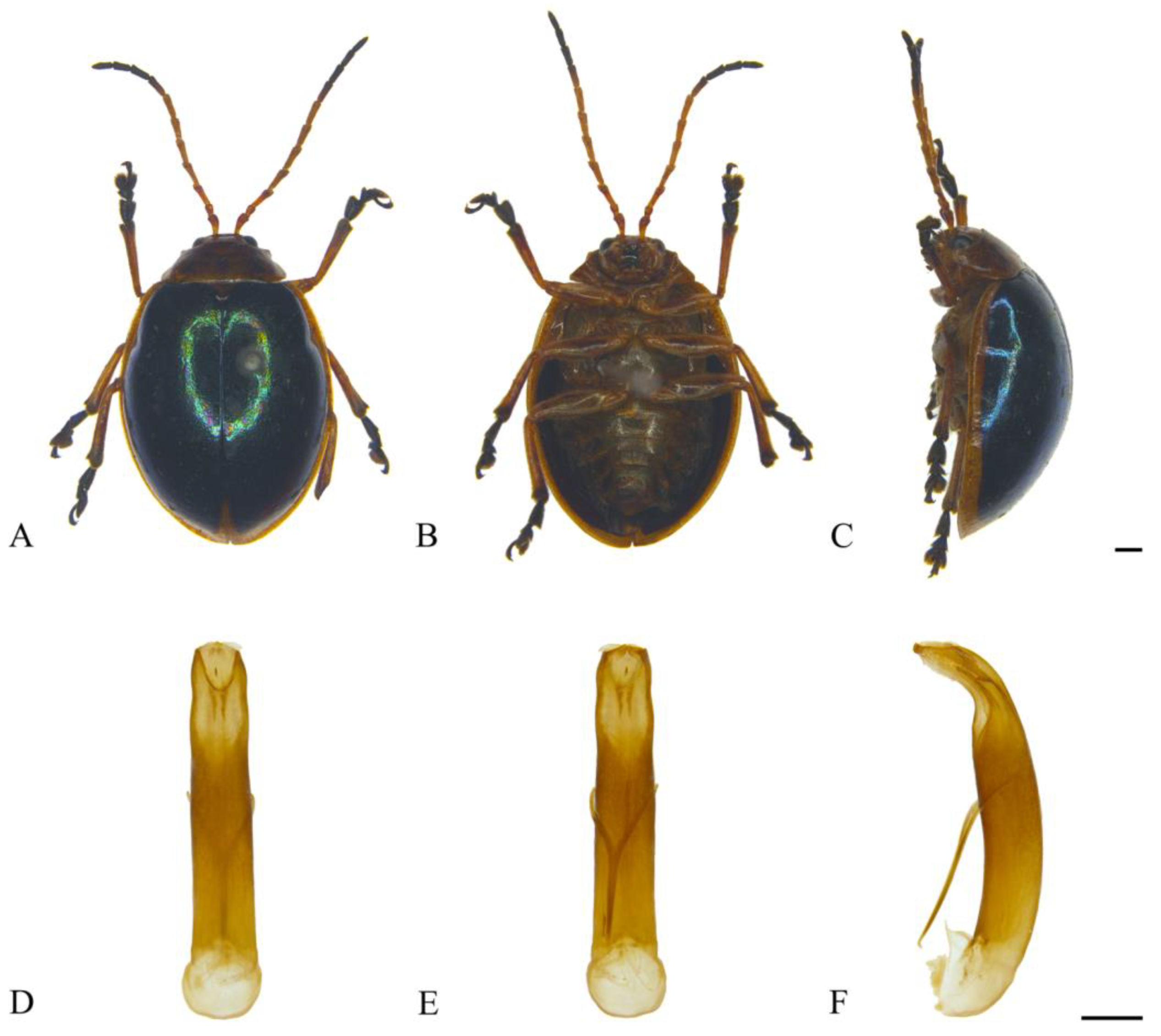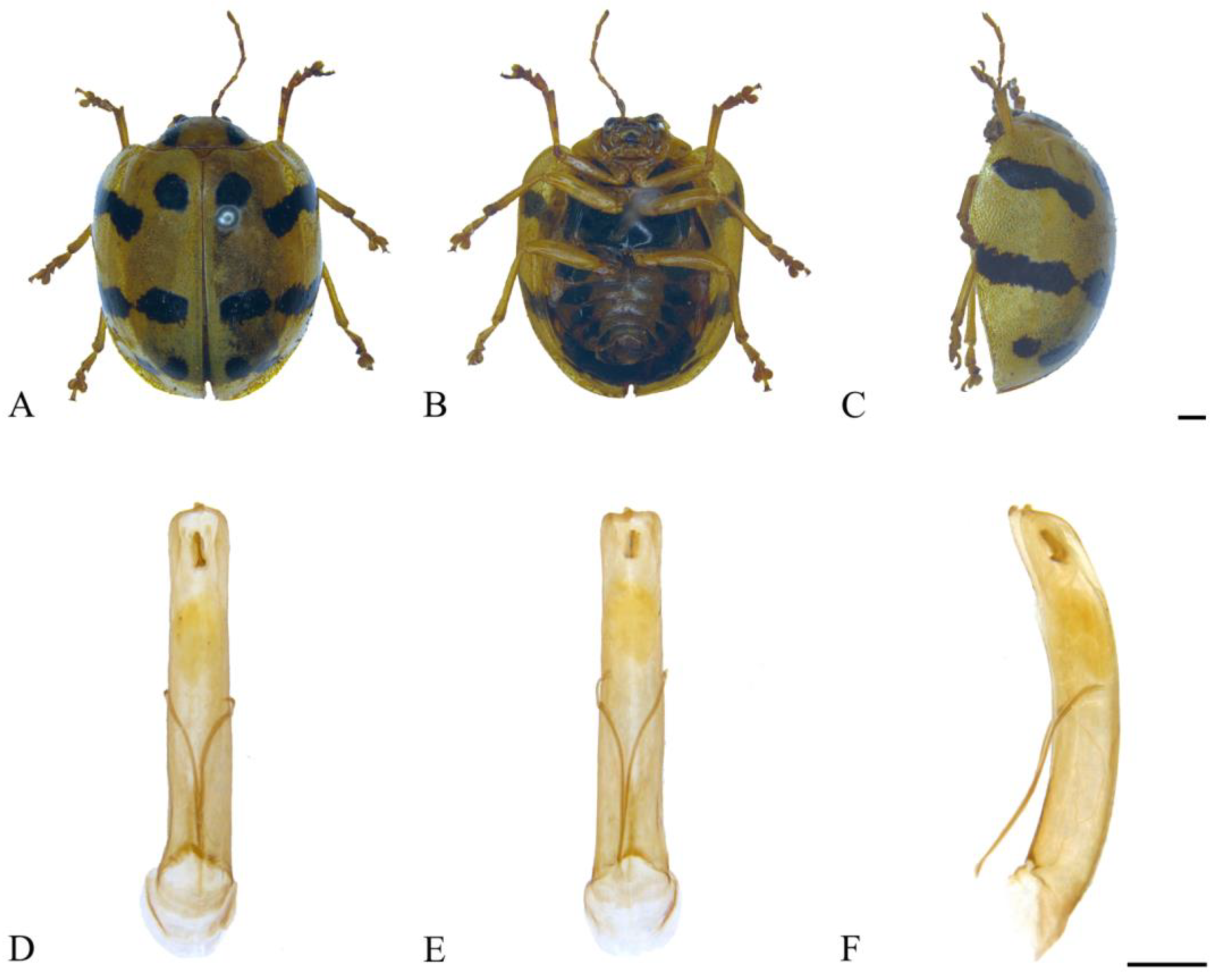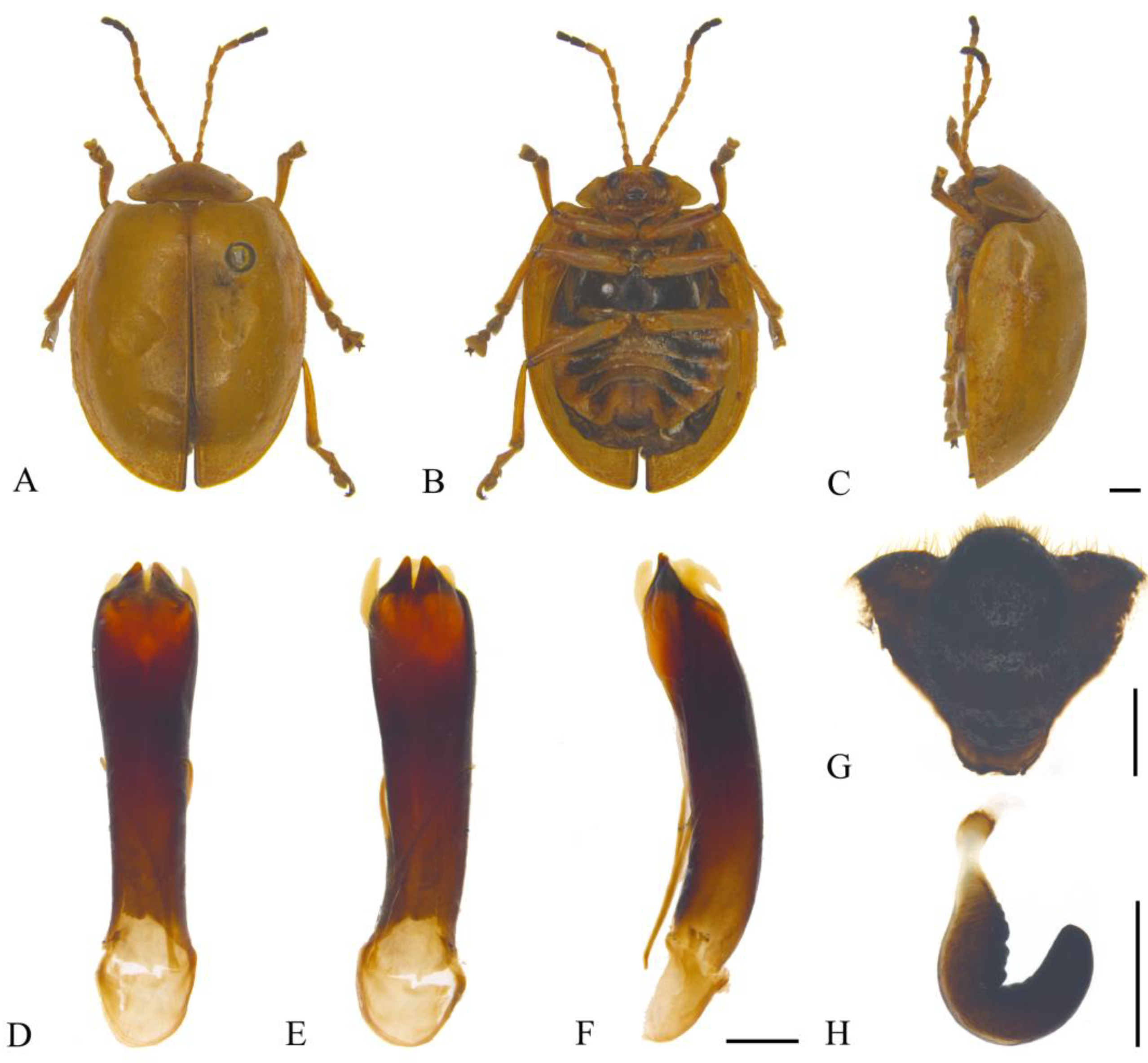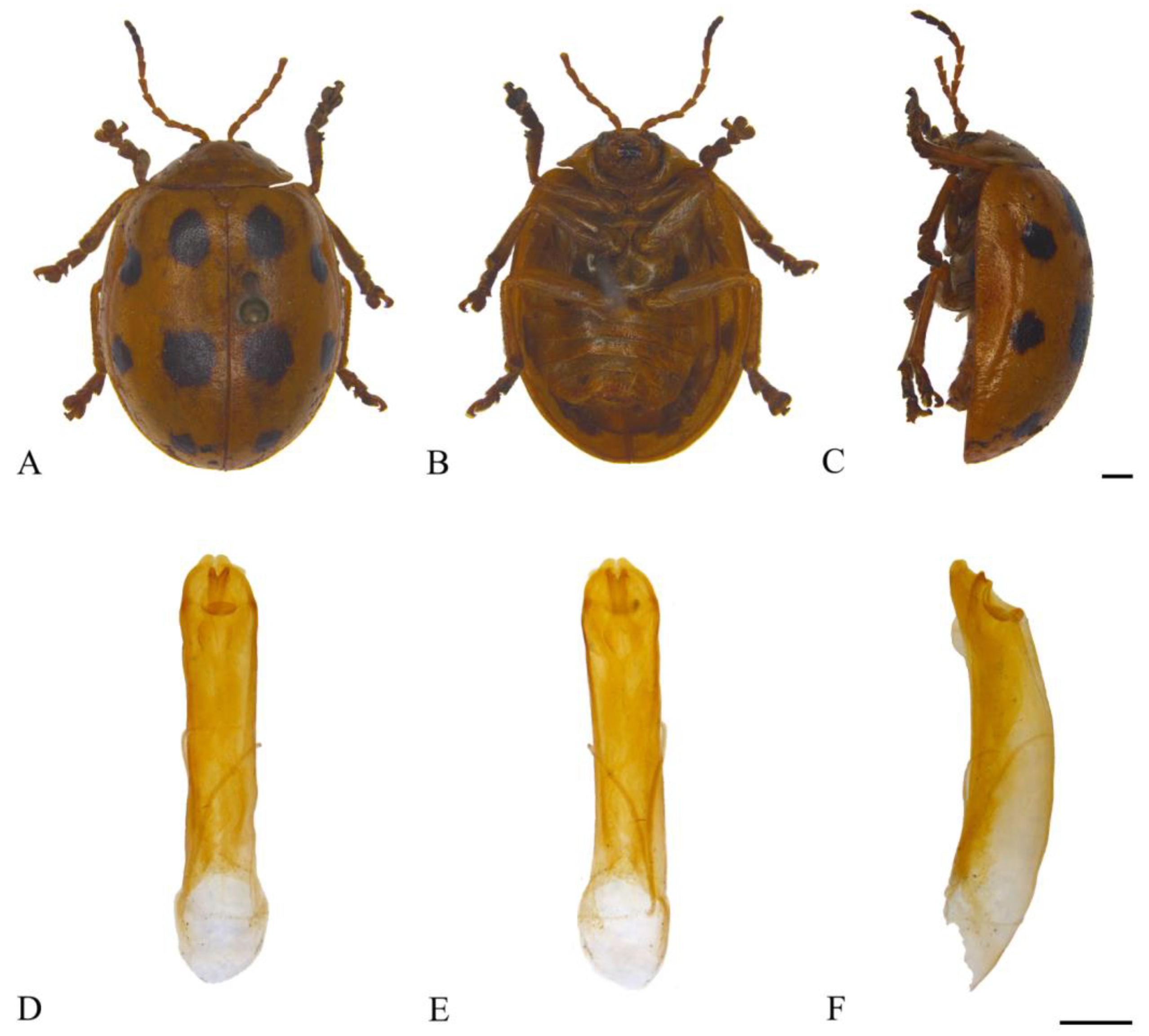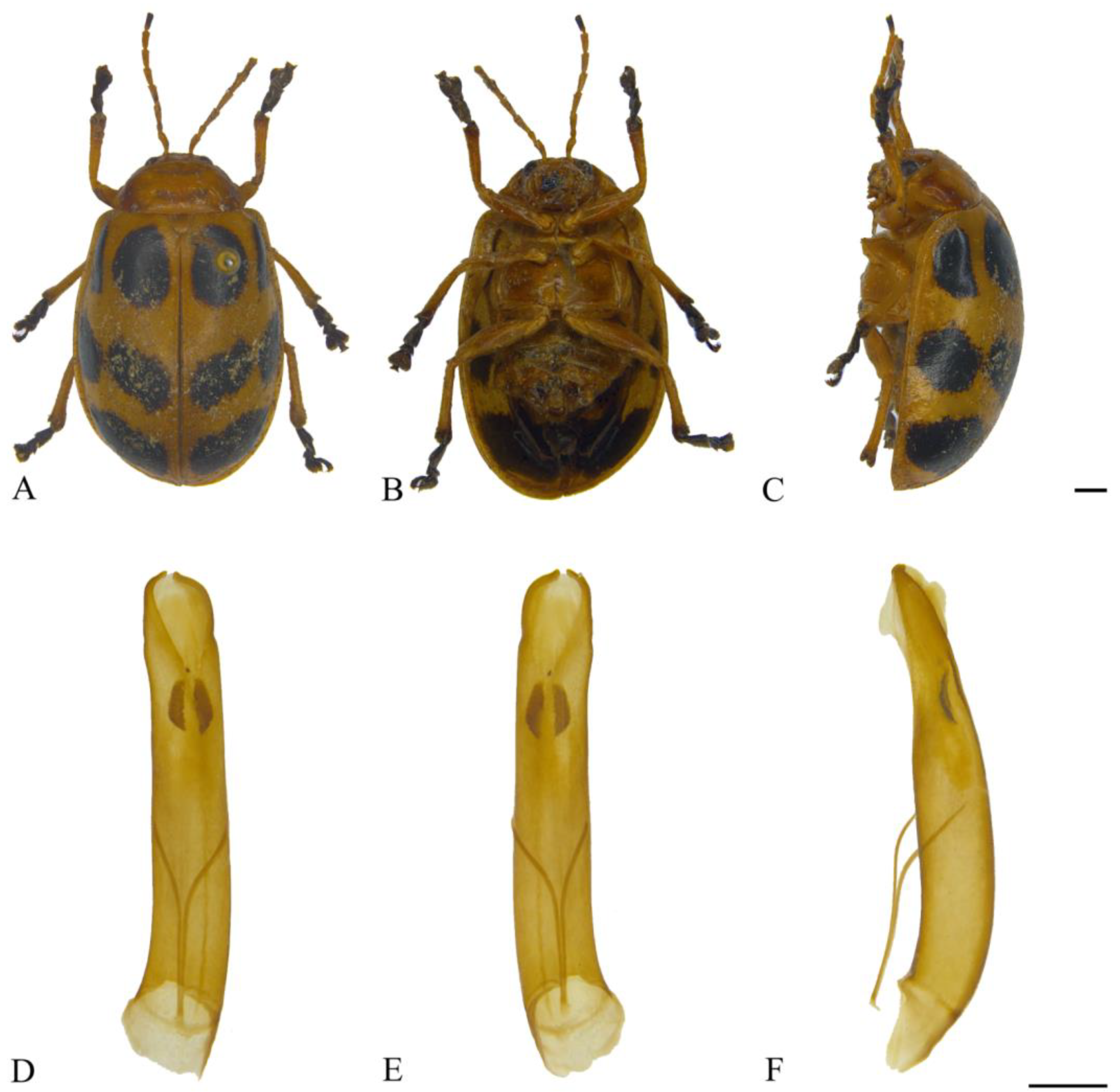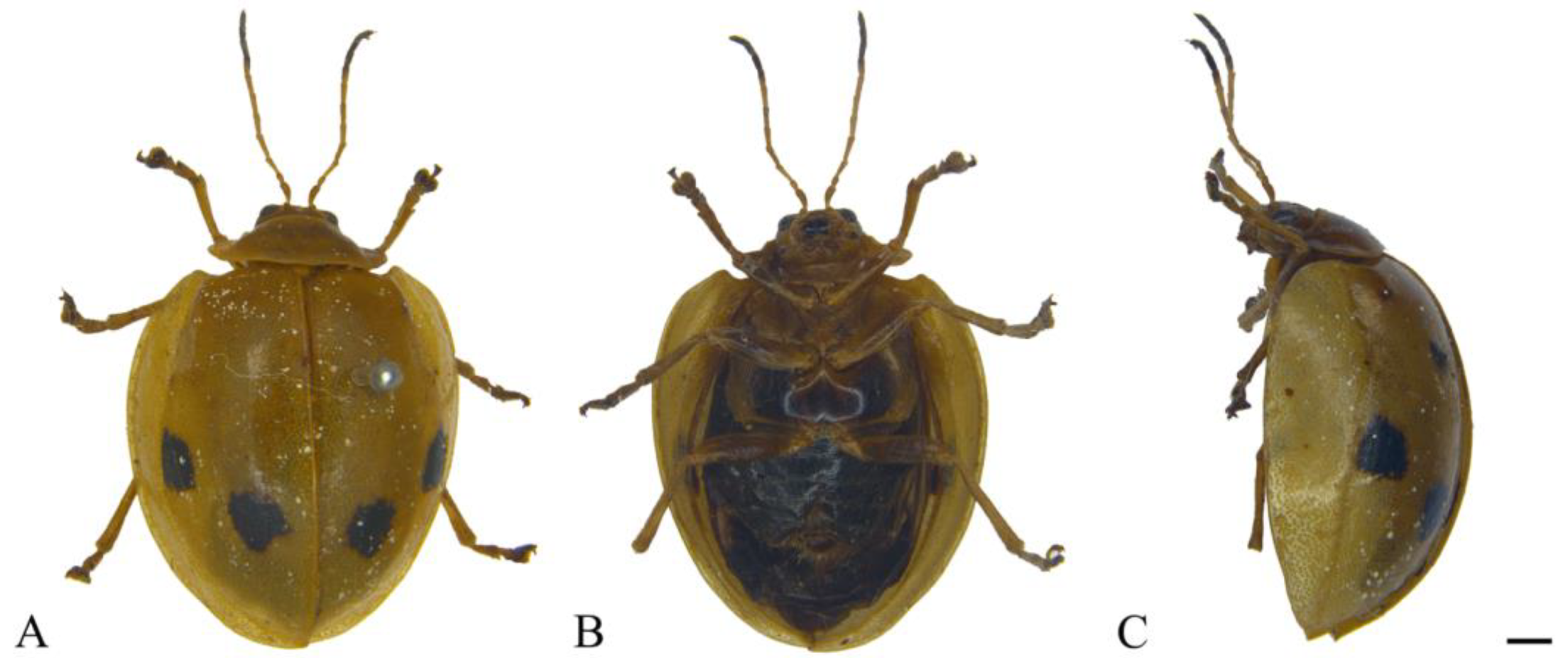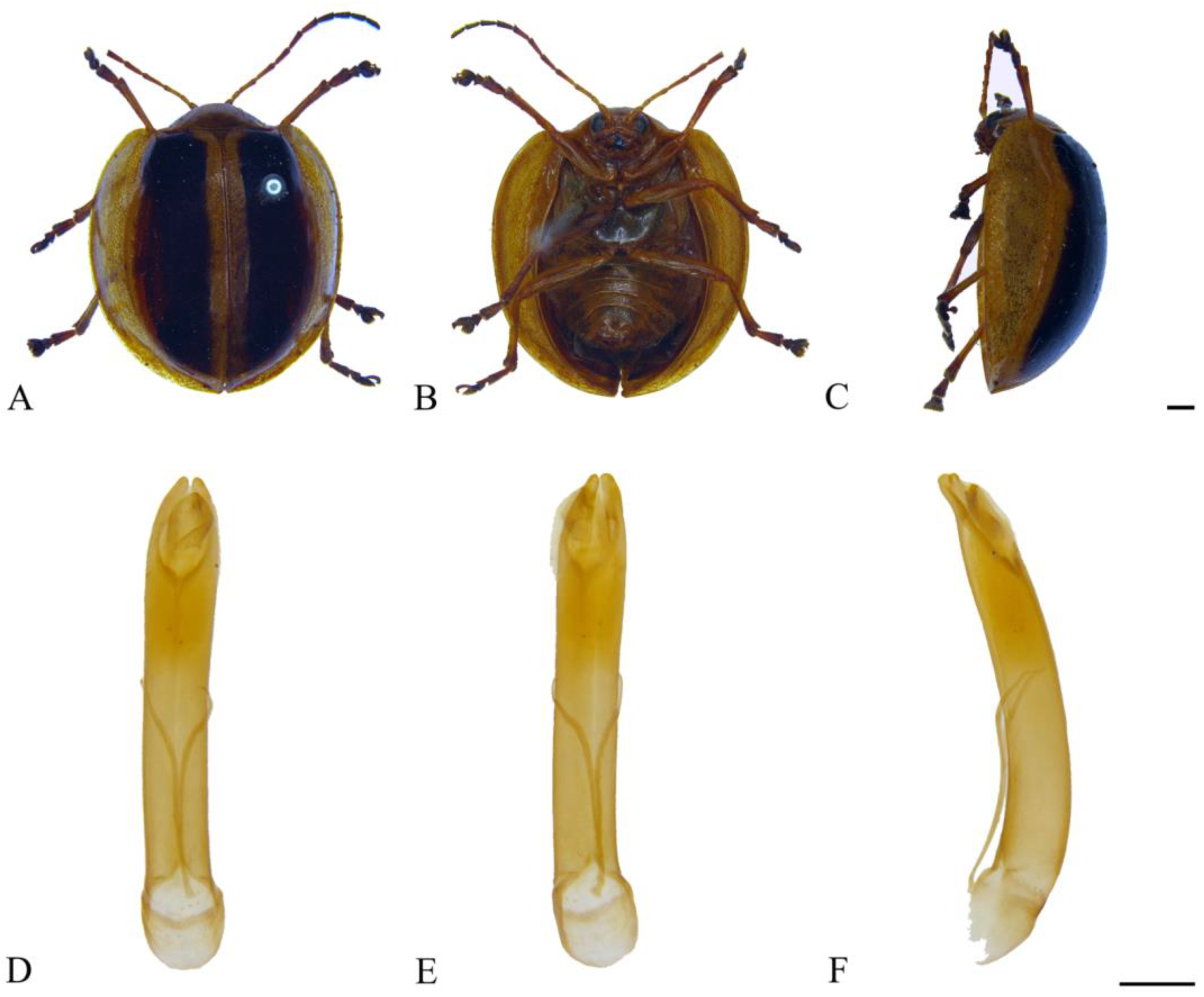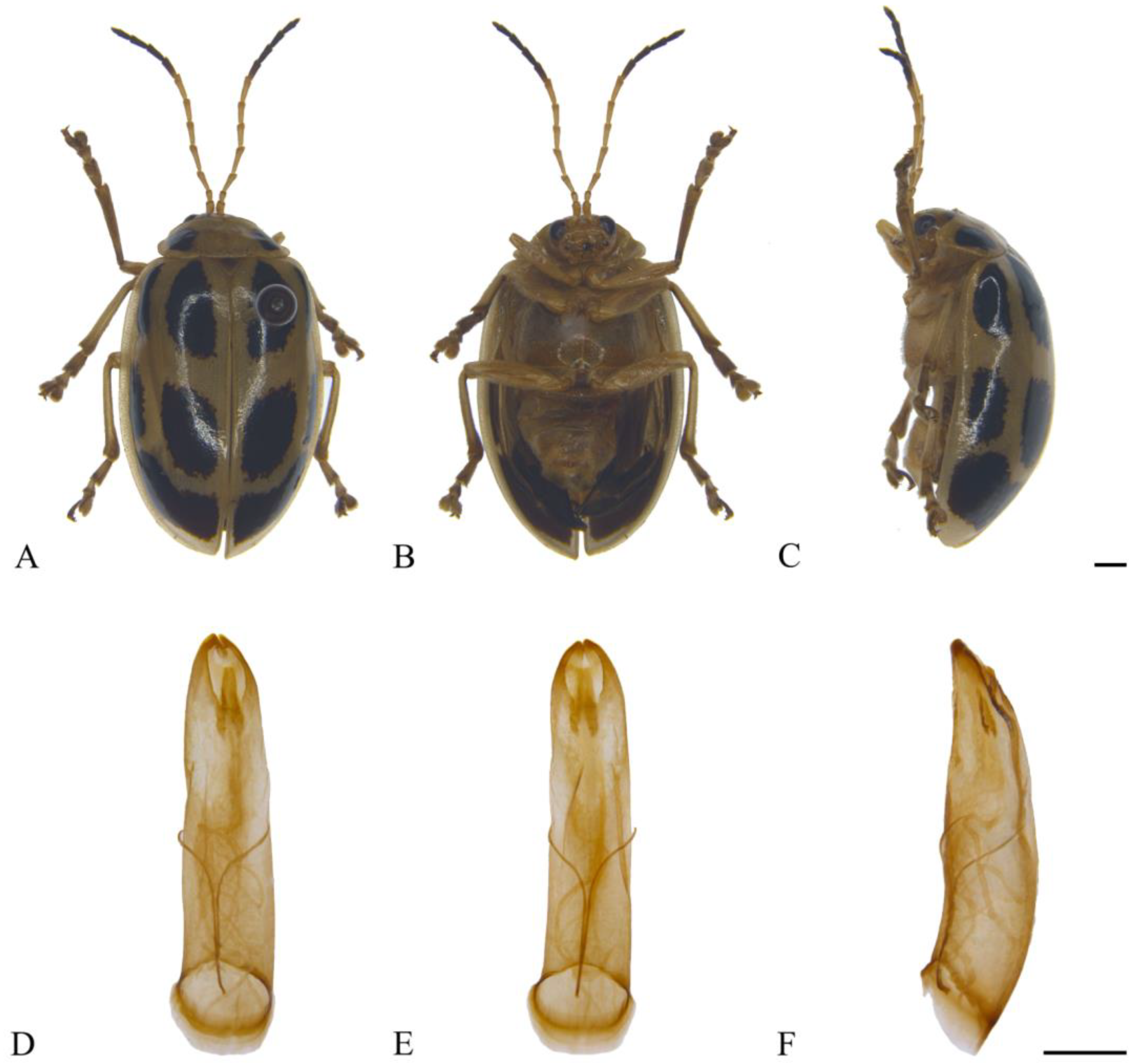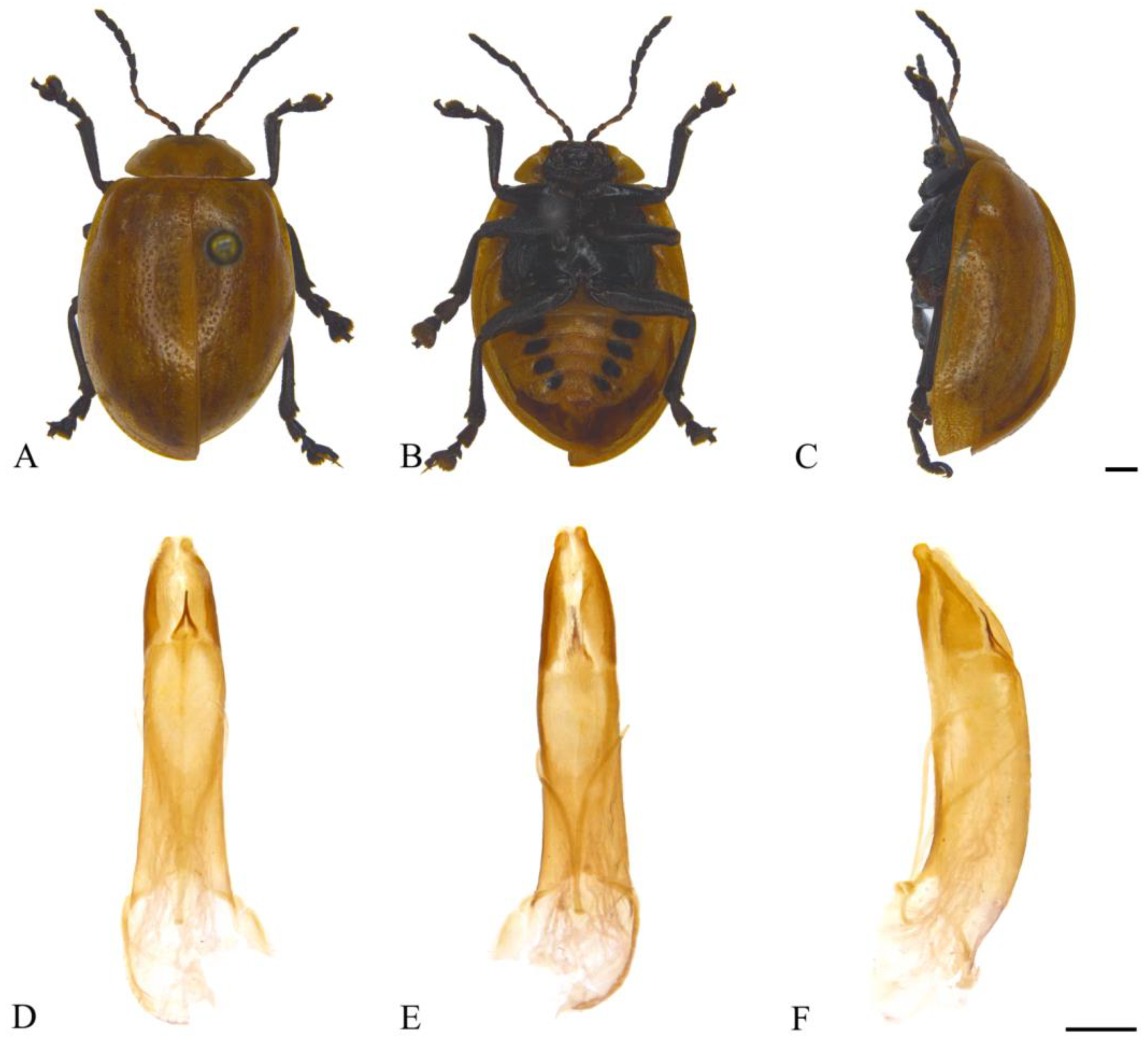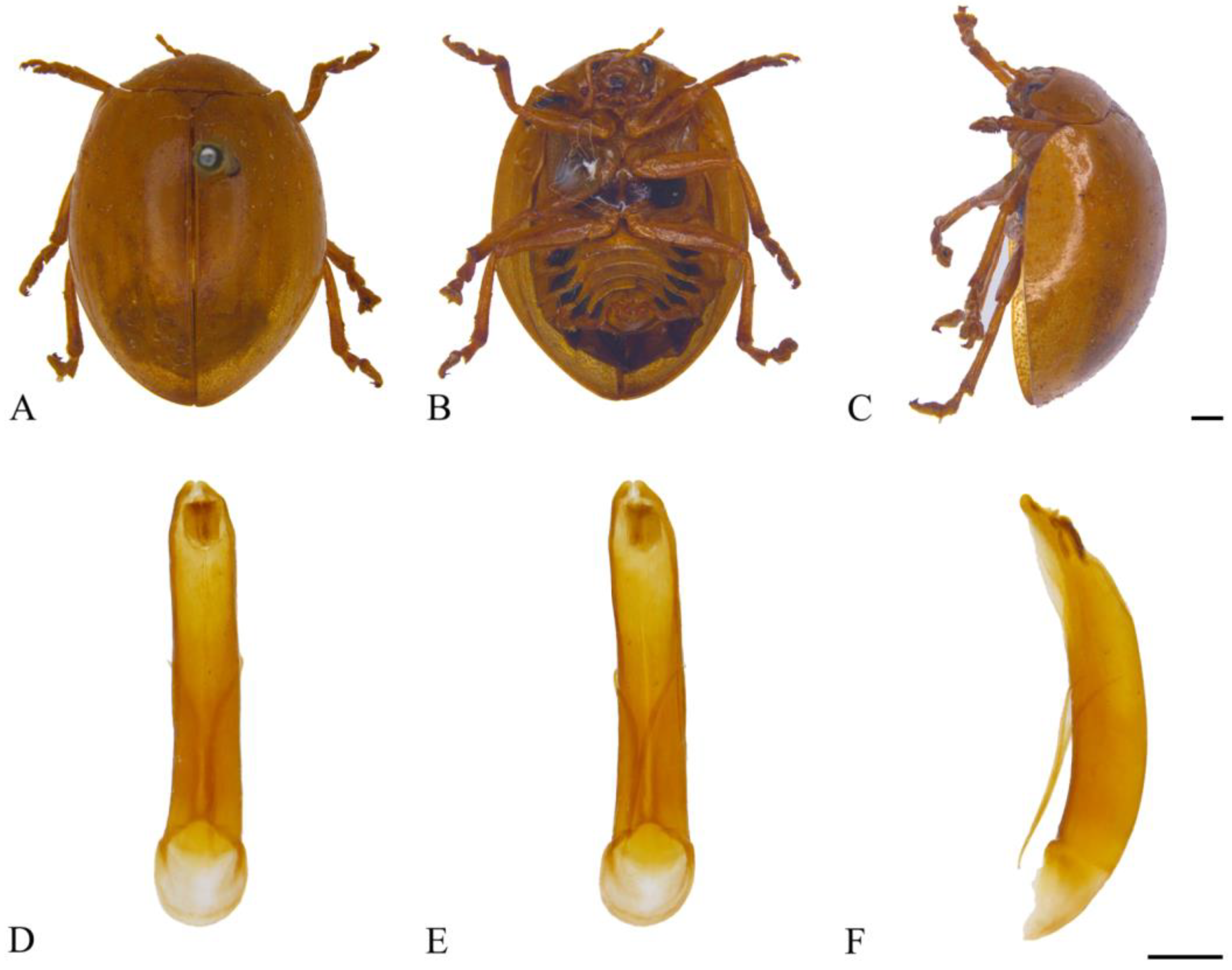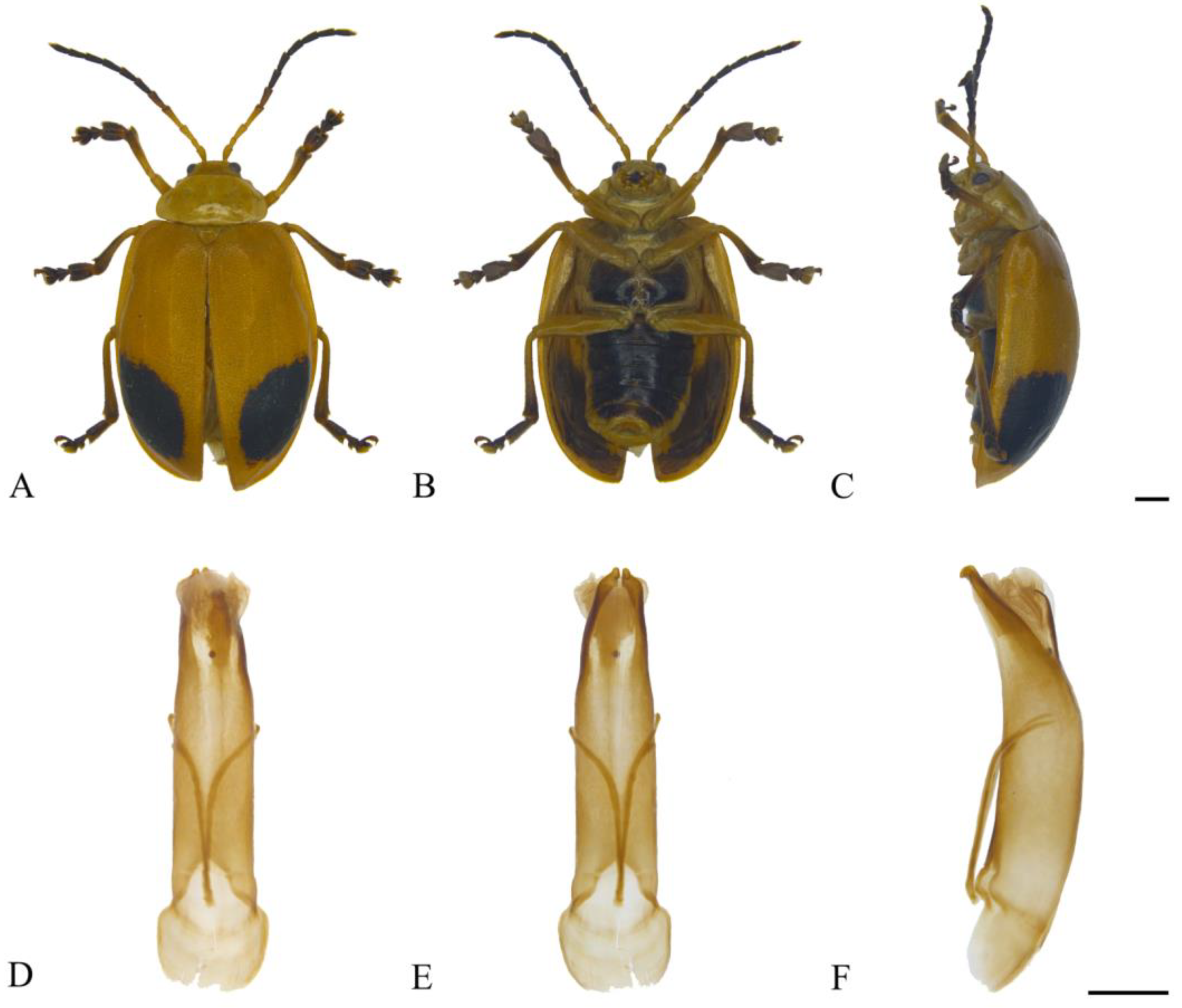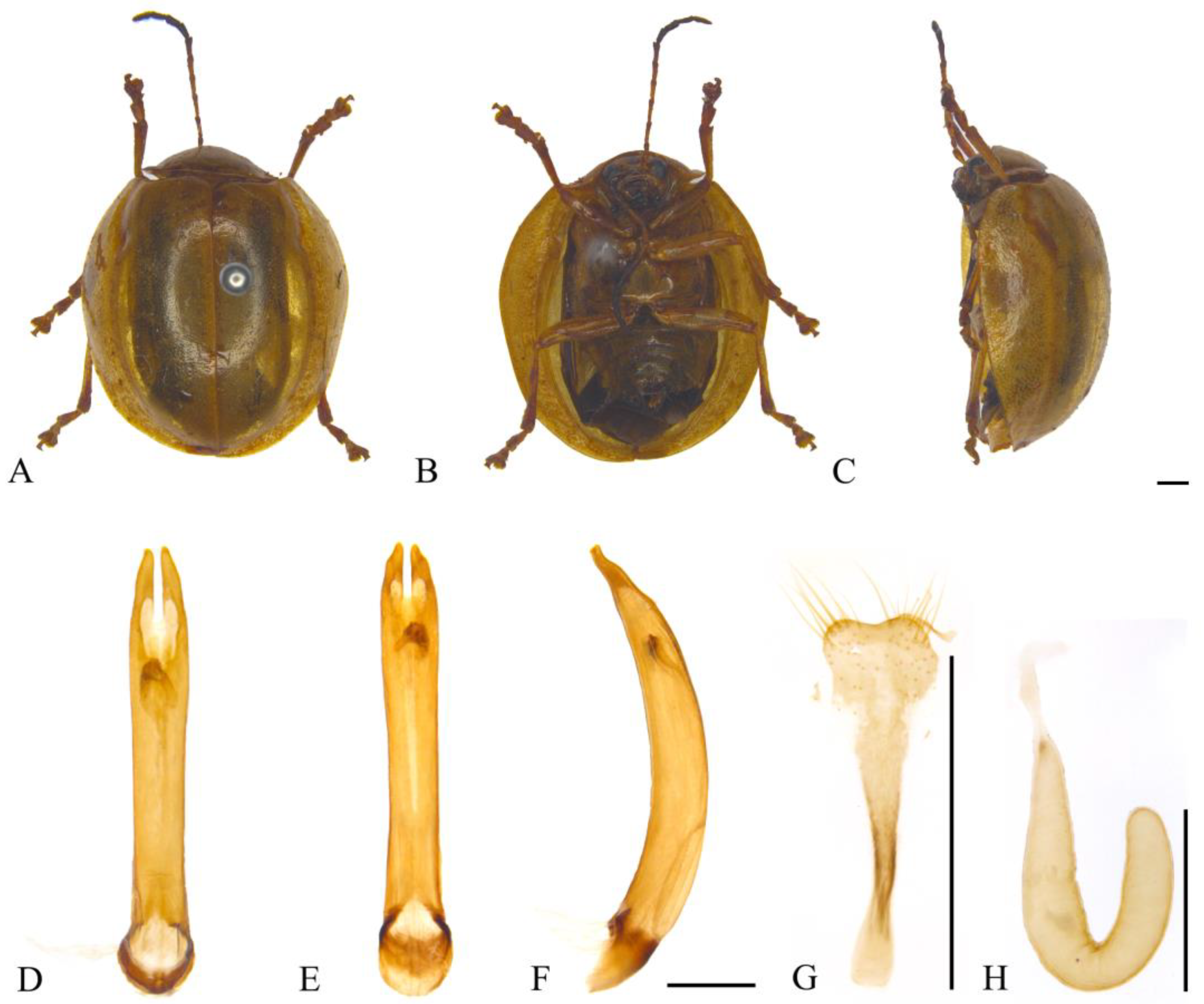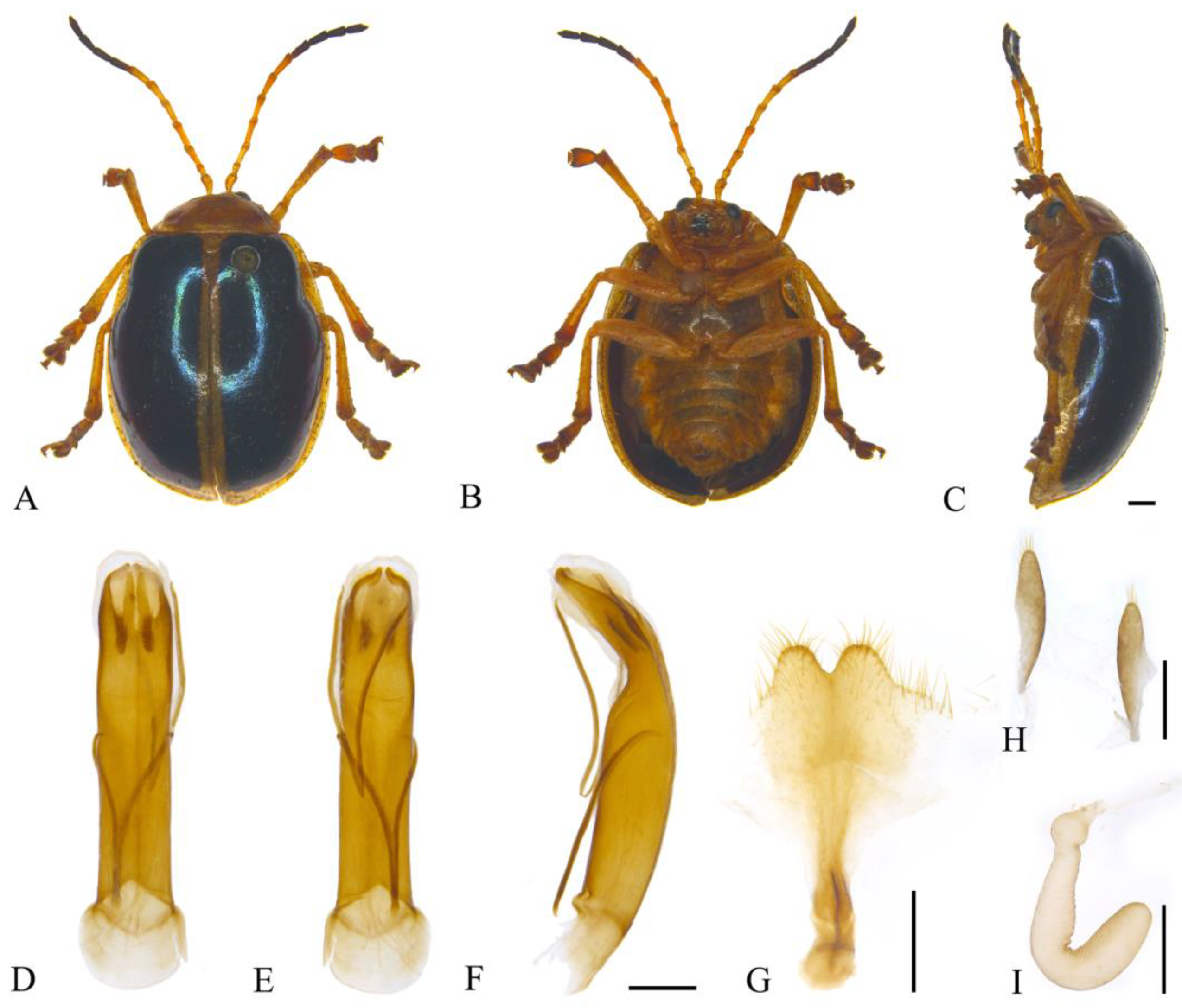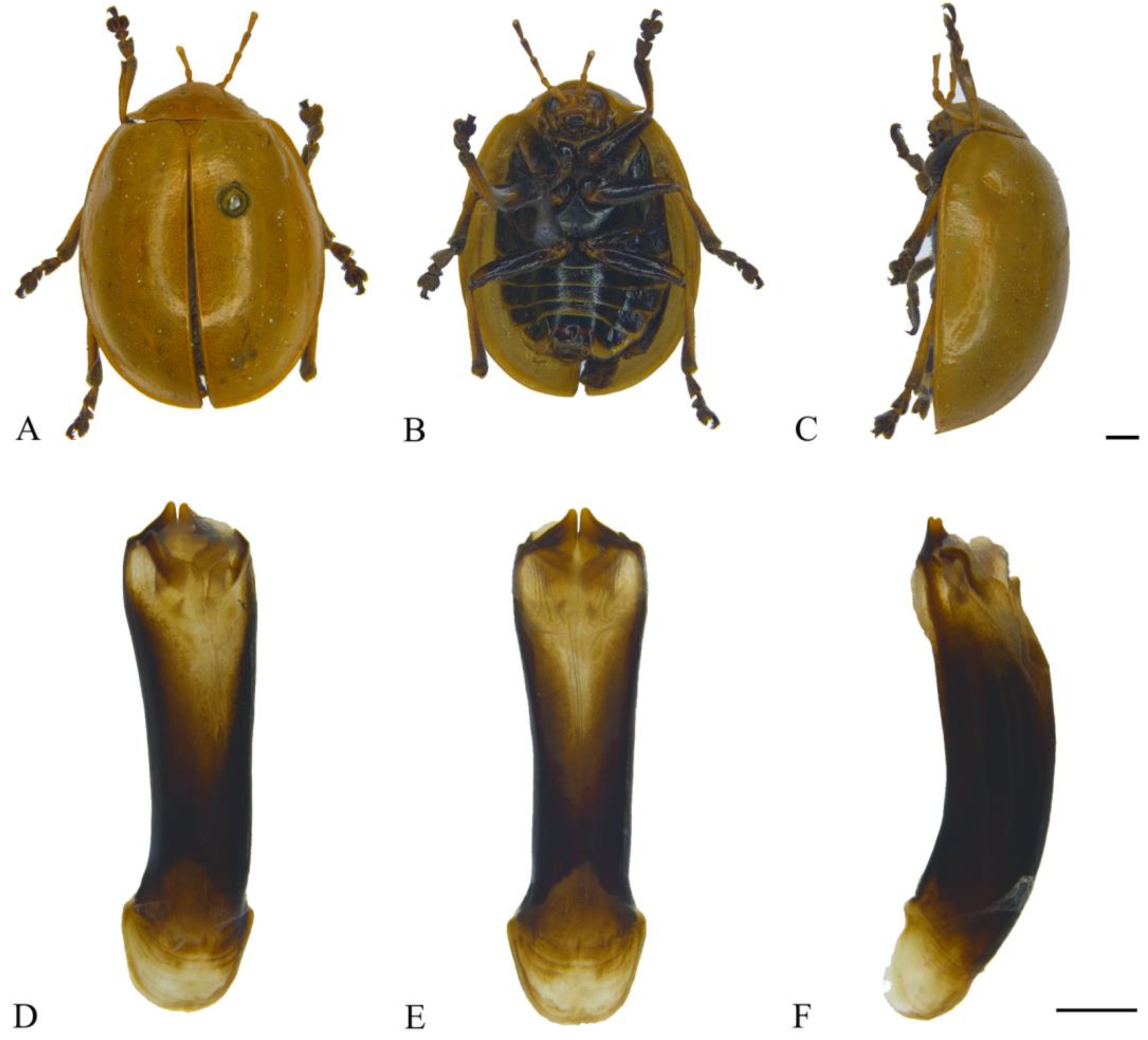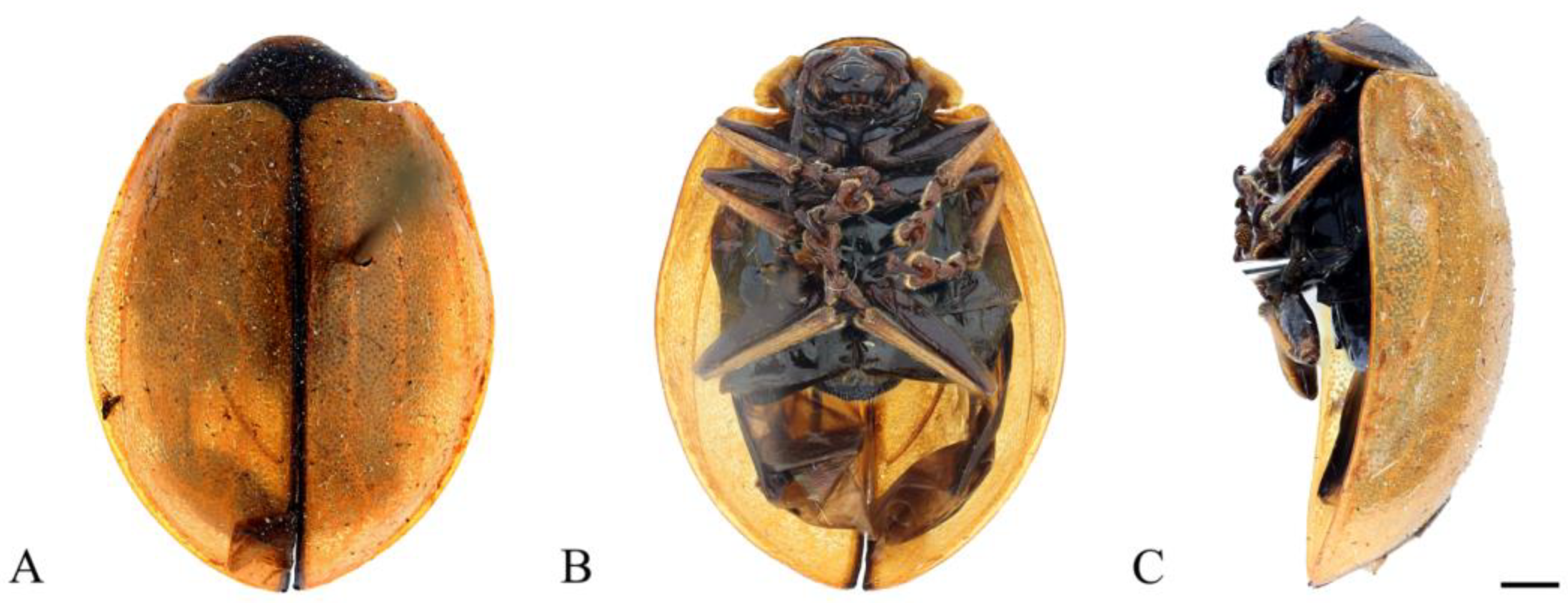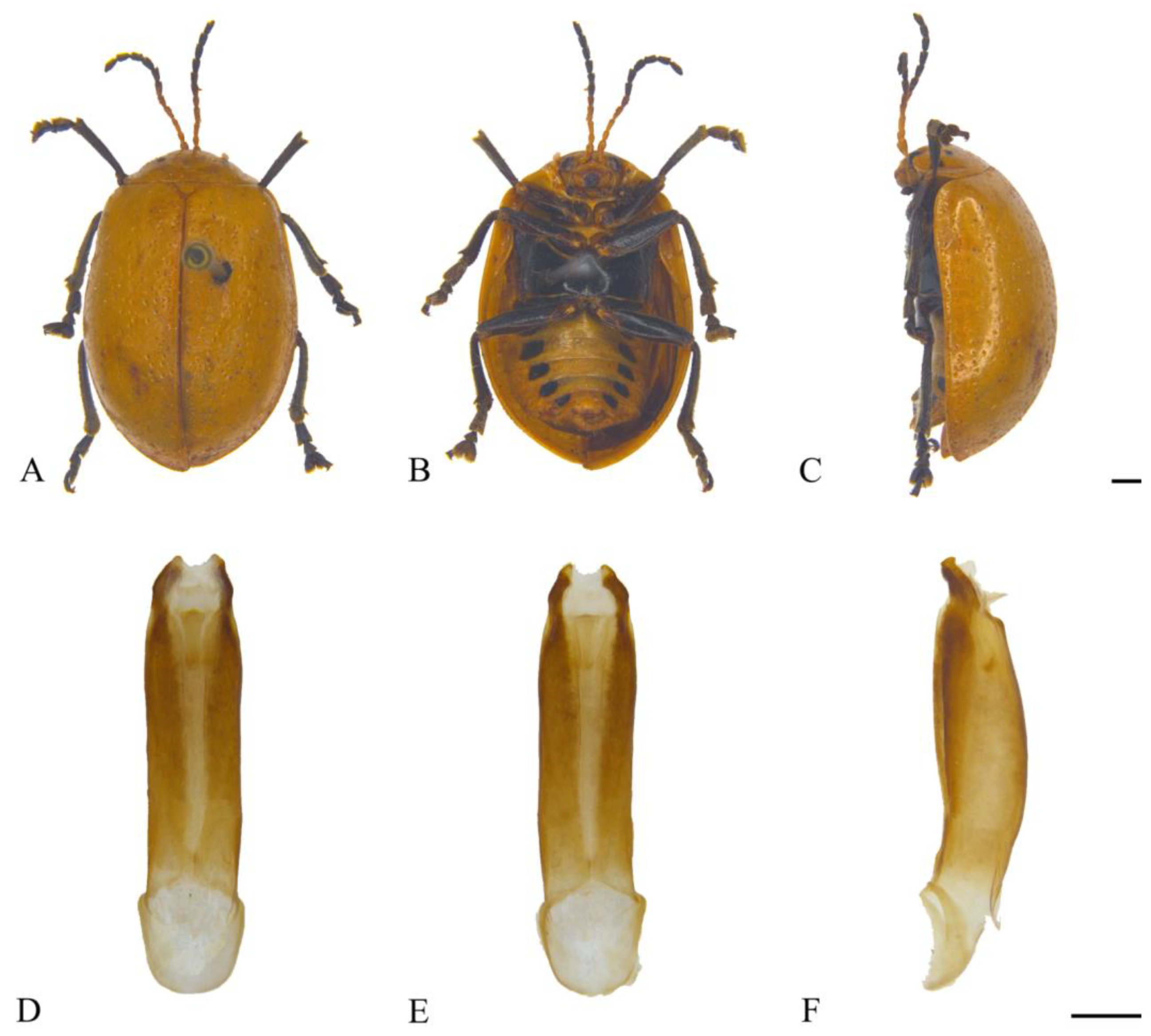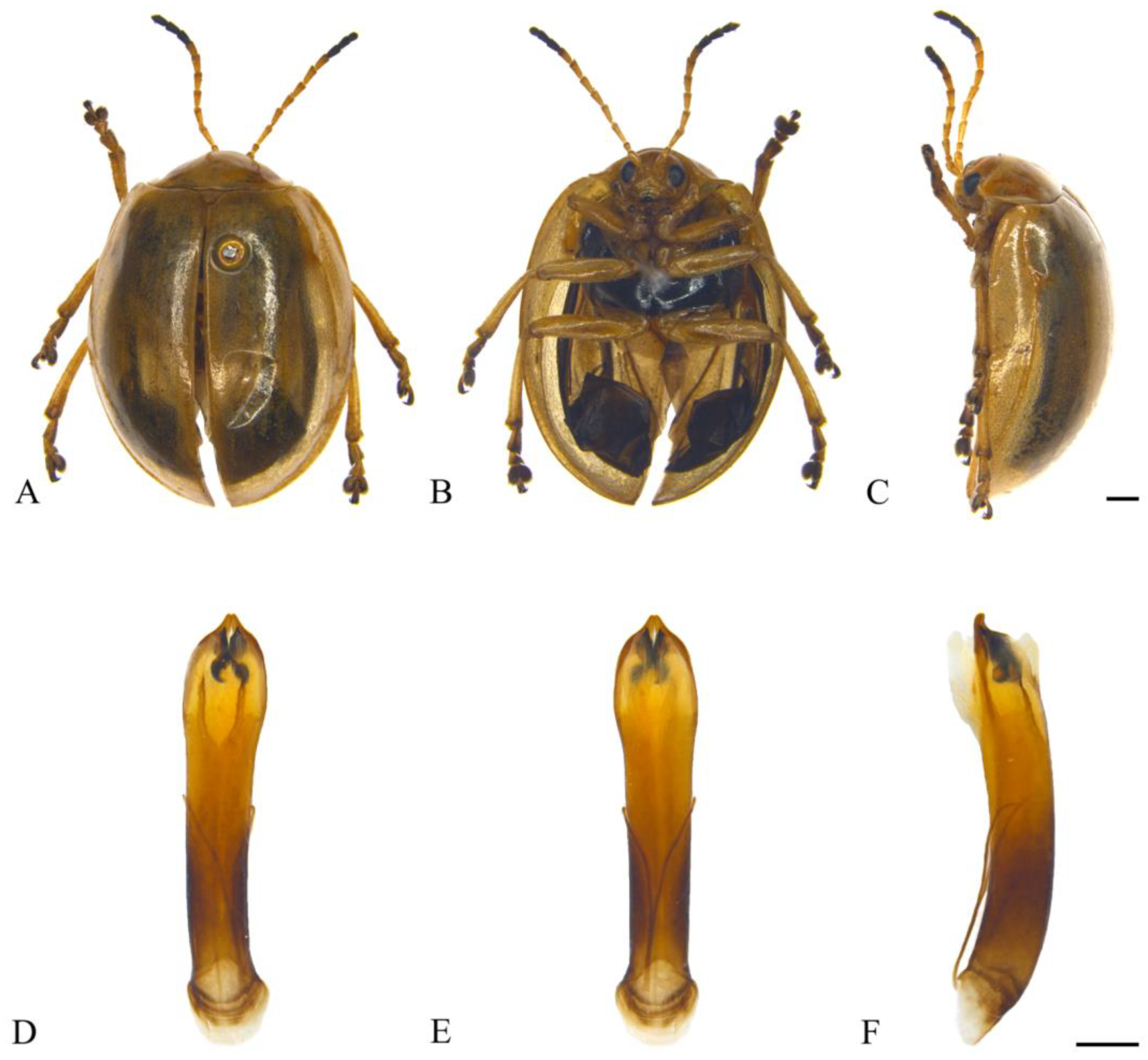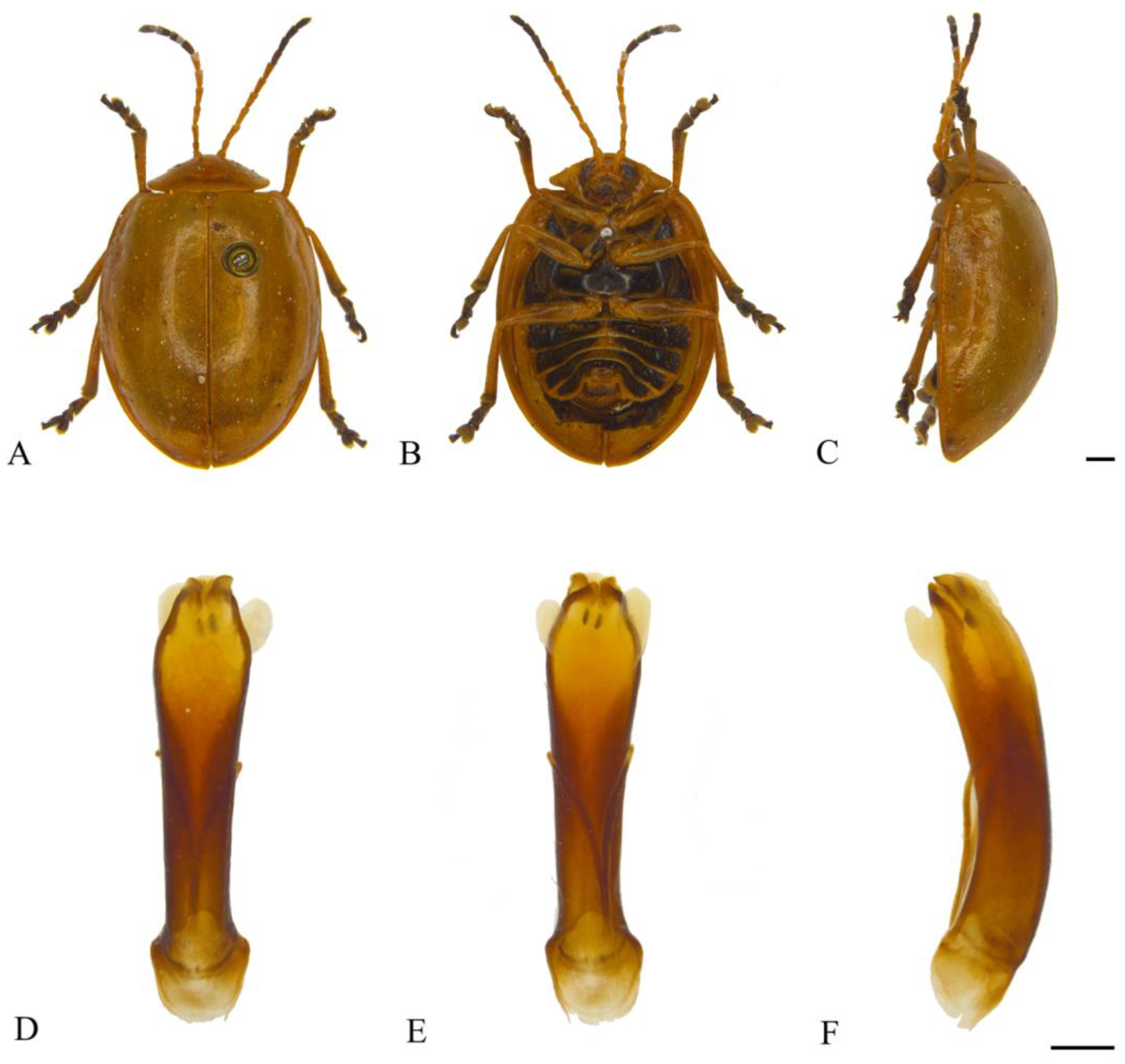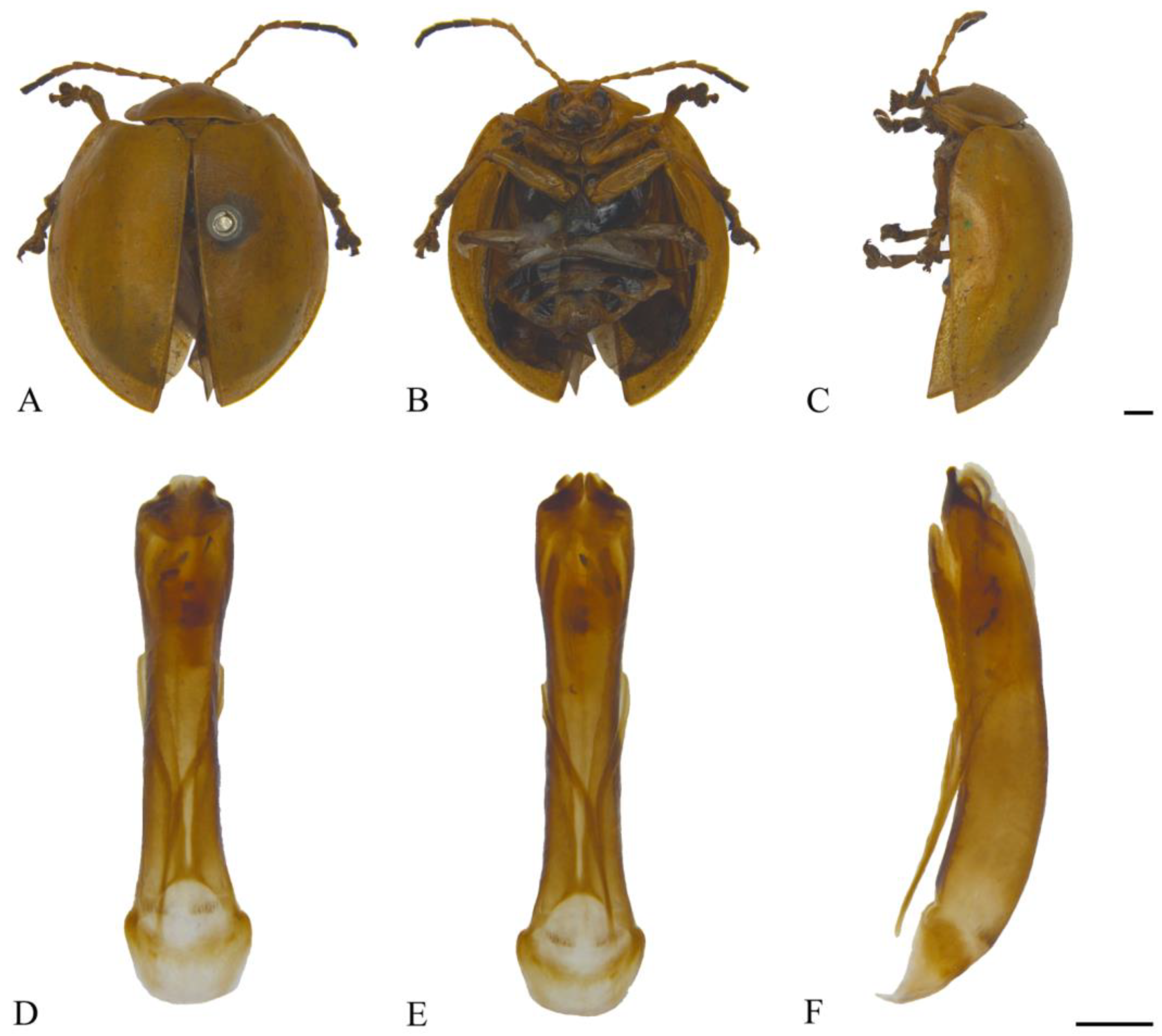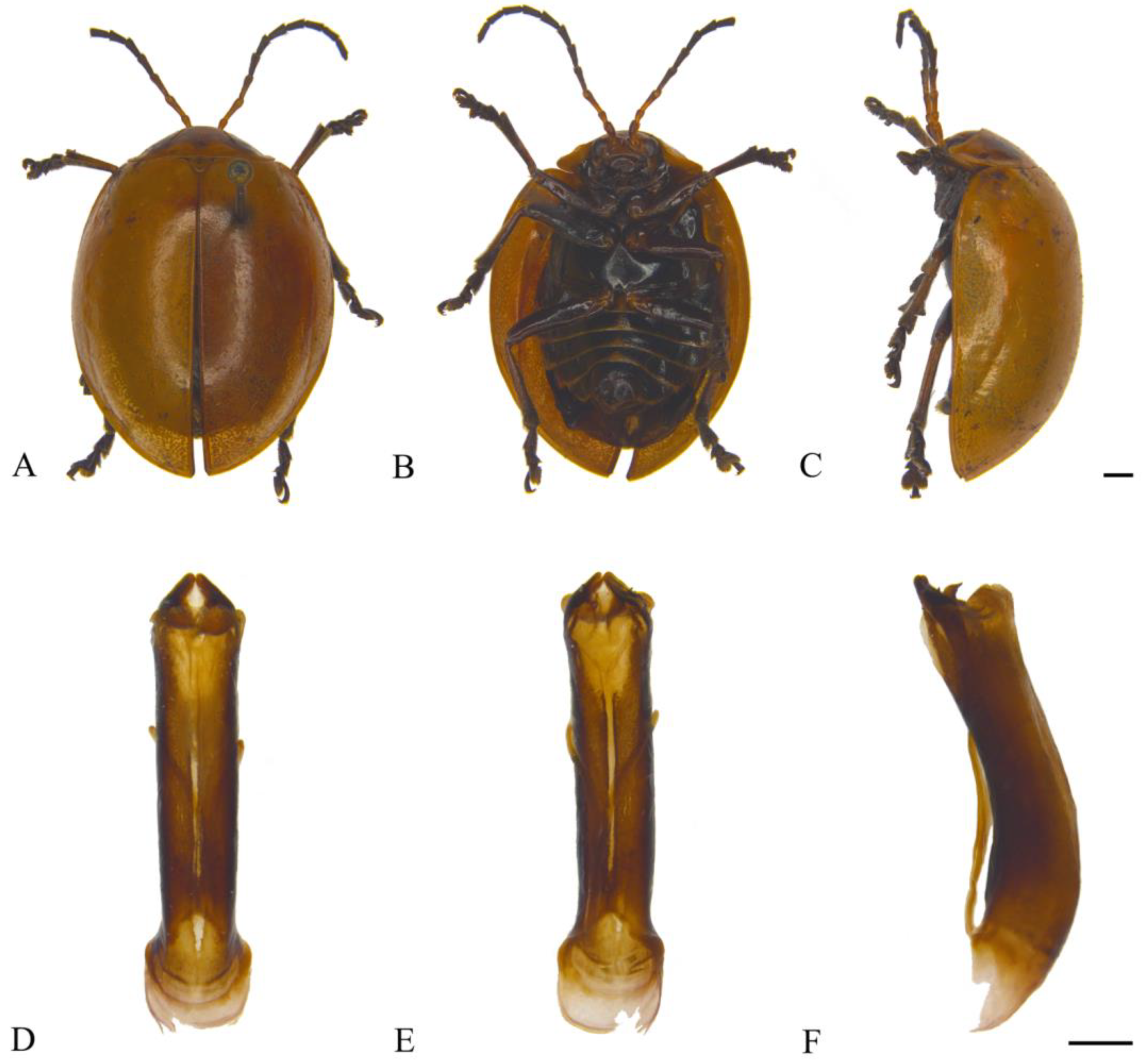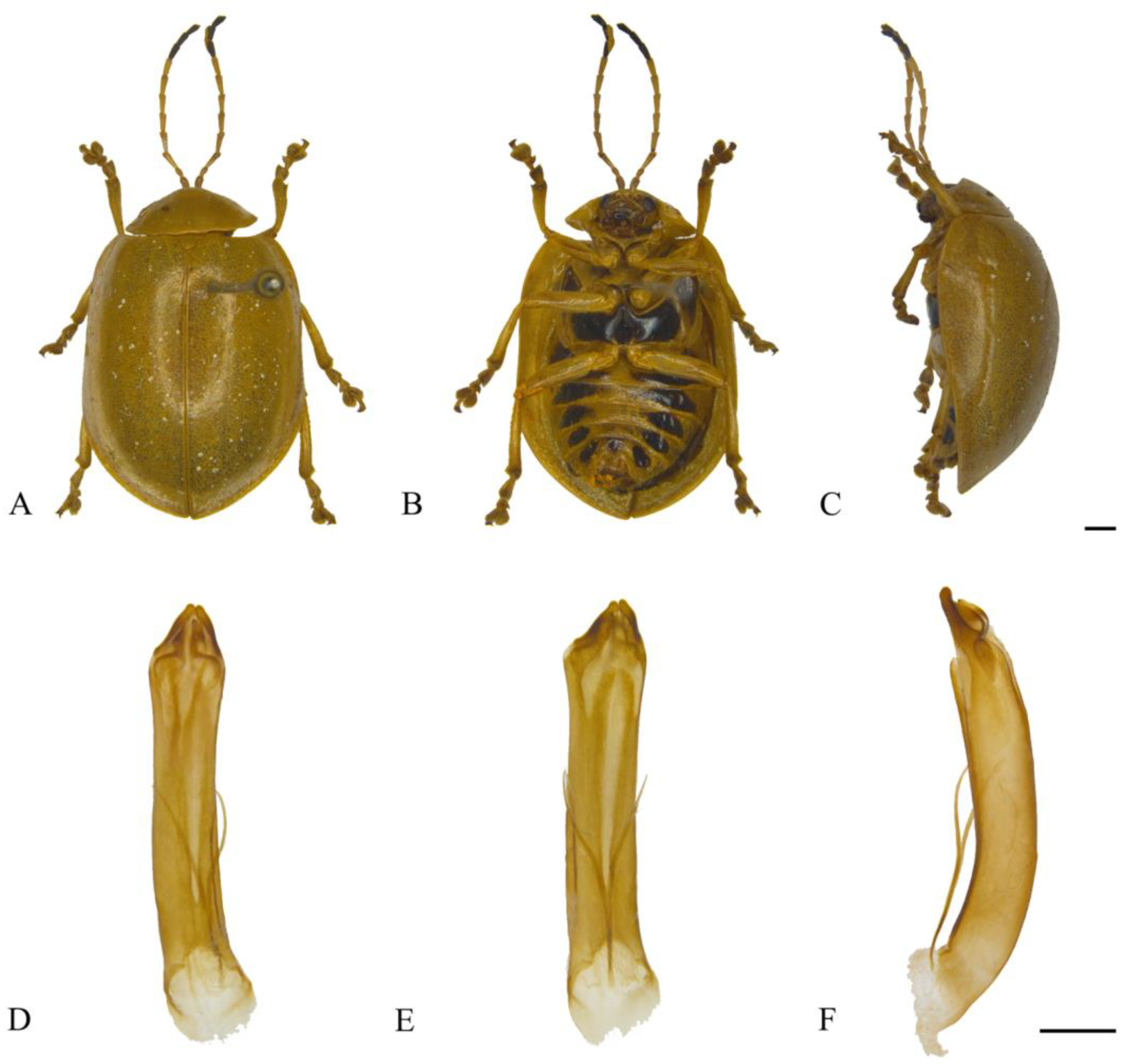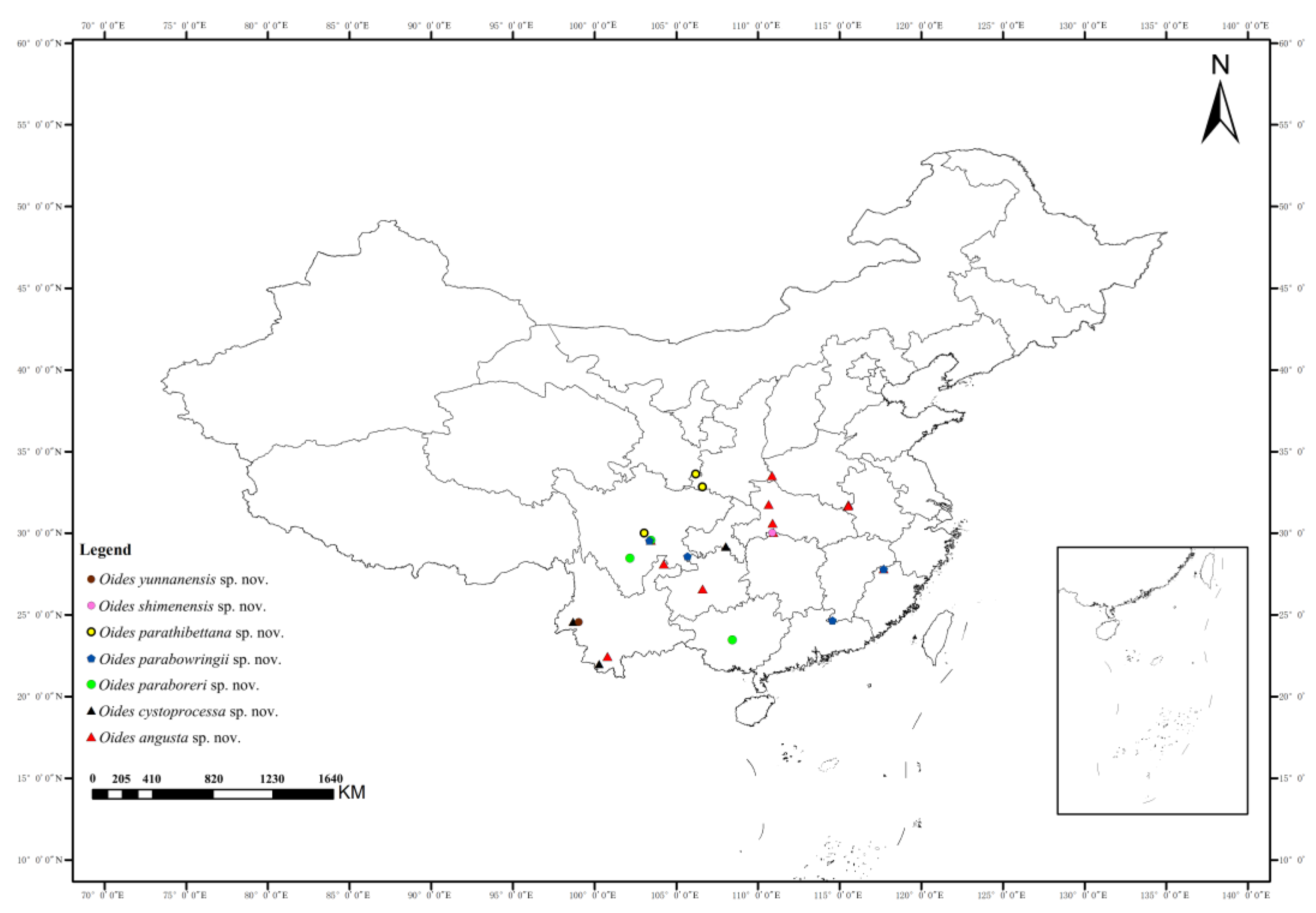3.2. Species Descriptions
3.2.1. Oides angusta sp. nov. (Figure 1A–I)
Description. Male. Length 9.5–13.0 mm, width 7.5–11.0 mm. Female. Length 13.0–14.5 mm, width 8.5–9.5 mm.
Body yellowish-brown. Antennomeres VIII–XI, metapleura and metasternum black; leg yellowish-brown, apex of tibia and ventral part of tarsus dark brown; abdomen yellowish-brown, each ventrite with one pair of black longitudinal spots. Antennae filiform, 3/5 the length of body; antennomere I dilated, II shortest, III longest, IV slightly shorter than III; V–VII subequal in length, slightly shorter than IV; VIII–XI subequal in length, slightly shorter than VII. Pronotum transverse, more than 2.0× wider than long; anterior margin concaved, front angles protruding anteriorly, back angles obtuse, disc with dense punctures. Scutellum tongue-like, smooth without punctures. Elytra oval, disc with dense punctures, diameter of puncture shorter than spacing between punctures; epipleurae narrower than 1/3 the width of elytra. Aedeagus well sclerotized, nearly parallel-sided; apex slightly enlarged in dorsal view, the dorsal apex processes on both sides lobate, terminal of apical processes on ventral side rounded; the aedeagus narrowed dorsally at basal 1/2 in lateral view. Female sternite VIII strongly sclerotized, apical margin wide, depressed medially, with dense setae. Gonocoxae U-shaped, paired gonocoxae connected by membrane, apical region widest, narrowed toward basal, apex with dense setae. Spermatheca strongly curved and hook-like, basal slender and slightly dilated with proximal end sclerotized; middle sclerotized, as wide as apex. Apical region strongly sclerotized and widely rounded.
Holotype: ♂, China, Hubei Prov., Shennongjia, 500 m, 3 June 1981, leg. Han Yinheng. Paratypes: China: 1♂, Henan Prov., Shangcheng Country, Suxianshi Town, Xihe Protection Station, 358.62 m, 7 October 2021, 31.73628° N, 115.54872° E, roadside, scrub, leg. Chenjun and Liang Hongbin; 1♂, Shaanxi Prov., Shangnan Country, 16 September 1982, hawkthorn, leg. Sun Yizhi (NWAFU); 1♂, Anhui Prov., Jinzhai Country, Tangjiahui Town, Jingangtai Village, Jingangtai, 485.18 m, 5 May 2021, 31.68366° N, 115.52624° E, tea garden, woods, leg. Zhao Kaidong and Zhu Xichao; 3♂1♀, Hunan Prov., Shimen Country, Hupingshan Town, Nanping Village, Maozhu River, 320 m, 13 October 2014, 30.6180° N, 110.9046° E, leg. Liang Hongbin; 1♀, Hunan Prov., Shimen Country, Hupingshan Town, Shangyanhe Village, 632 m, 16 October 2014, 30.0477° N, 110.9503° E, leg. Liang Hongbin; 1♂, Fujian Prov., Chong’an Country, Xing Village, Tongmuguan, 900–1150 m, 30 May 1960, leg. Zhang Yiran; 1♂, Sichuan Prov., Mt. Emei, Baoguo Temple, 550–750 m, 9 July 1957, leg. Lu Youcai; 1♂, Yunnan Prov., Yanjin Country, 1000 m, 19 June 1980, leg. Hu Zongli; 1♂, Yunnan Prov., Xishuangbanna, Menghun, 1200–1400 m, 18 May 1958, leg. Zhang Yiran; 2♂, Guizhou Prov., Guiyang City, Yeyatang, 1980, collector unknown.
Figure 1.
Oides angusta sp. nov. (A) Habitus, dorsal view; (B) habitus, ventral view; (C) habitus, lateral view; (D) aedeagus, dorsal view; (E) aedeagus, ventral view; (F) aedeagus, lateral view; (G) female sternite VIII; (H) gonocoxae; (I) spermatheca. Scale bars: 1 mm.
Figure 1.
Oides angusta sp. nov. (A) Habitus, dorsal view; (B) habitus, ventral view; (C) habitus, lateral view; (D) aedeagus, dorsal view; (E) aedeagus, ventral view; (F) aedeagus, lateral view; (G) female sternite VIII; (H) gonocoxae; (I) spermatheca. Scale bars: 1 mm.
Diagnosis. The new species is similar to Oides tarsata (Baly), but antennomere III is longer than IV; epipleurae is narrower, and the morphology of male genitalia is completely different.
Etymology. The specific name is derived from the Latin word “angustus”, referring to the aedeagus constricts dorsally at the middle.
Distribution. China (
Figure 2): Henan, Shaanxi, Anhui, Hubei, Hunan, Fujian, Sichuan, Guizhou, Yunnan.
3.2.2. Oides bowringii (Baly, 1863) (Figure 3A–F)
Adorium bowringii Baly, 1863: 623 [
17].
Oides bowringii: Harold, 1876: 3555 [
5].
Oides elegans Laboissière, 1919: 161 [
18]. Synonymized by Gressitt & Kimoto, 1963: 476 [
19].
Oides tonkinensis Laboissière, 1929: 252 [
20]. Synonymized by Kimoto, 1989: 36 [
21].
Specimens examined. China: 1♂, Shaanxi Prov., Nanzheng Country, date and collector unknown; 1♀, Zhejiang Prov., Mt. Tianmu, 500–1000 m, 22 July 1973, leg. Yu Peiyu; 1♀, Hubei Prov., Xuanen Country, Xiaoguan, 1000 m, 4 August 1989, leg. Mai Guoqing; 1♀, Jiangxi Prov., Longnan Country, Mt. Jiulian, 9 June 1975, leg. Zhang Youwei; 1♀, Hunan Prov., Hengyang City, Nanyue, 1100 m, August 1963, collector unknown; 1♀, Hunan Prov., Yongshun Country, Shanmuhe State Forest Farm, 600 m, 9 August 1988, leg. Wang Shuyong; 1♀, Hunan Prov., Zhangjiajie City, 8 August 2001, collector unknown; 1♂, Fujian Prov., Chong’an Country, Xingcun Town, Tongmuguan, 800–1000 m, 21 July 1960, leg. Jiang Shengqiao; 1♀, Fujian Prov., Jiangle Country, Mt. Longqi, 650 m, 13 June 1991, leg. Yang Longlong; 1♂, Guangxi Prov., Longsheng Country, Sanmen Town, 300 m, 21 June 1963, leg. Shi Yongshan; 1♂, Guangxi Prov., Mt. Mao’er, 1150 m, 8 July 1985, leg. Liao Subai; 1♀, Guangxi Prov., Huaping, 12 July 1983, collector unknown; 1♀, Guangxi Prov., Baishou Country, 3 July 1952, collector unknown; 1♂, Sichuan Prov., Mt. Emei, Xixiangchi, 1800–2000 m, 12 August 1957, leg. Zhu Fuxing; 1♂, Sichuan Prov., Wenchuan Country, Yingxiu Town, 900 m, 1 August 1983, leg. Wang Shuyong; 1♀, Sichuan Prov., Wan Country, Wang’erbao, 1200 m, 10 August 1993, leg. Song Shimei; 1♂, Sichuan Prov., Jiangjin Country, 17 August 1979, collector unknown; 1♂, Guizhou Prov., Dasha River, Xiannvdong, 650–1150 m, 21–23 August 2004, leg. Yang Maofa; 1♂, Guizhou Prov., Jiangkou Country, Mt. Fanjing, 530 m, 12 July 1988, leg. Wang Shuyong; 1♂, Guizhou Prov., Maolan Town, Dongtang, 25 May 1998, leg. Song Qiongzhang; 1♂, Guizhou Prov., Jiangkou Country, Mt. Fanjing, 530 m, 12 July 1988, leg. Wang Shuyong; 1♂, Guizhou Prov., Mt. Leigong, 14 August 1988, leg. Li Yongkun; 1♂, Yunnan Prov., Pingbian Country, Mt. Dawei, 1350 m, 21 June 1956, leg. Bonfilov; 1♂, Yunnan Prov., Pingbian Country, Mt. Dawei, 1500 m, 17 June 1956, leg. Huang Keren; 1♂, Yunnan Prov., Pingbian Country, Mt. Dawei, 1350 m, 21 June 1956; 1♀, Yunnan Prov., Dongshan Country, No.12 Bridge to Dulongjiang, 27°42′54″ N, 98°30′8″ E, 2770 m, 30 April 2002, leg. Liang Hongbin, Ba Weidong and Li Xiangqian.
Distribution. China: Shaanxi, Gansu, Zhejiang, Hubei, Jiangxi, Hunan, Fujian, Guangdong, Hainan, Hongkong, Guangxi, Sichuan, Guizhou, Yunnan; Japan; Vietnam; Laos; Myanmar.
Host plant. Schisandra chinensis (Turczaninow).
Figure 3.
Oides bowringii (Baly) (♂). (A) Habitus, dorsal view; (B) habitus, ventral view; (C) habitus, lateral view; (D) aedeagus, dorsal view; (E) aedeagus, ventral view; (F) aedeagus, lateral view. Scale bars: 1 mm.
Figure 3.
Oides bowringii (Baly) (♂). (A) Habitus, dorsal view; (B) habitus, ventral view; (C) habitus, lateral view; (D) aedeagus, dorsal view; (E) aedeagus, ventral view; (F) aedeagus, lateral view. Scale bars: 1 mm.
3.2.3. Oides coccinelloides Gahan, 1891 (Figure 4A–F)
Oides coccinelloides Gahan, 1891: 458 [
22].
Specimens examined. China: 1♀, Yunnan Prov., Ruili City, 1400 m, 6 June 1956, leg. Zhou Benshou; 1♂, Xizang, Motuo Country, Xirang Village, 800 m, 4 August 1974, leg. Huang Fusheng; 1♂, Xizang, Motuo Country, Pangxin Village, 1700 m, 19 June 1998, leg. Yao Jian; 1♀, Xizang, Motuo Country, Gandai, 2150 m, 25 June 1998, leg. Yao Jian; 1♀, Xizang, Motuo Country, Bangxin Village, 1300–1500 m, 11 July 1982, leg. Han Yinheng; 1♀, Xizang, Motuo Country, Beibeng Village, 800–1200 m, 10 June 1983, leg. Han Yinheng.
Distribution. China: Yunnan, Xizang; India; Myanmar.
Figure 4.
Oides coccinelloides Gahan (♂). (A) Habitus, dorsal view; (B) habitus, ventral view; (C) habitus, lateral view; (D) aedeagus, dorsal view; (E) aedeagus, ventral view; (F) aedeagus, lateral view. Scale bars: 1mm.
Figure 4.
Oides coccinelloides Gahan (♂). (A) Habitus, dorsal view; (B) habitus, ventral view; (C) habitus, lateral view; (D) aedeagus, dorsal view; (E) aedeagus, ventral view; (F) aedeagus, lateral view. Scale bars: 1mm.
3.2.4. Oides cystoprocessa sp. nov. (Figure 5A–H)
Description. Male. Length 10.5–11.5 mm, width 7.5–8.5 mm. Female. Length 11.0–11.5 mm, width 7.5–8.5 mm.
Body yellowish-brown. Antennomeres IX–XI, metapleura and metasternum black; leg yellowish-brown, conjunction of tibia and tarsus dark brown; abdomen yellowish-brown, each ventrite with one pair of black longitudinal spots. Antennae filiform, 3/5 the length of the body; antennomere I dilated, II shortest, III longest, IV distinctly shorter than III; V–VII subequal in length, slightly shorter than IV; VIII–XI subequal in length, slightly shorter than VII. Pronotum transverse, about 2.0× wider than long; anterior margin concaved, front angles protruding anteriorly, back angles obtuse, disc with scattered indistinct punctures. Scutellum tongue-like, smooth without punctures. Elytra oval, disc with dense punctures, diameter of puncture longer than spacing between punctures; epipleurae about 1/3 the width of elytra. Aedeagus well sclerotized, widening from about basal 1/2 to apex in dorsal view; dorsal apical processes sharp; everted endophallus developed in ventral view; apex slightly dilated in lateral view. Female sternite VIII strongly sclerotized, shield-like, medial area projecting anteriorly and erect, and apical margin truncate with dense setae. Gonocoxae reduced. Spermatheca strongly sclerotized and curved, hook-like; proximal end of basal sclerotized, distal end of basal membranous and constricted; middle and apical regions equal in width, surface wrinkled, and apex widely rounded.
Holotype: ♂, China, Yunnan Prov., Xishuangbanna, Mengzhe, 1200 m, 3 July 1958, leg. Wang Shuyong. Paratypes: China: 1♂1♀, Chongqing City, Pengshui Country, Mowei Mountain scenic zone, 1585 m, 23 May 2017, 29.1766° N, 108.0314° E, leg. Zhao Kaidong; 1♀, Chongqing City, Pengshui Country, Mowei Mountain scenic zone, 1585 m, 22–23 May 2017, 29.1766° N, 108.0314° E, leg. Song Zhishun; 1♀, Chongqing City, Pengshui Country, Mowei Mountain scenic zone, 1482 m, 22 May 2017, 29.1926° N, 108.0428° E, leg. Liu Hong and Zhao Kaidong; 1♂, Yunnan Prov., Longling Country, 1600 m, 20 May 1955, leg. Zhao Yi; 1♂, Yunnan Prov., Xishuangbanna, Mengzhe, 1150 m, 25 July 1958, leg. Wang Shuyong.
Diagnosis. The new species is similar to Oides parathibettana sp. nov., but antennomeres IX-XI are black; everted endophallus of aedeagus is developed in lateral view, apex is acute; aedeagus constricts ventrally at basal 1/2.
Etymology. The specific name is derived from the Latin prefix “cysto-” and the Latin word “processus”, referring to the developed everted endophallus in ventral view.
Distribution. China (
Figure 2): Chongqing, Yunnan.
Figure 5.
Oides cystoprocessa sp. nov. (A) Habitus, dorsal view; (B) habitus, ventral view; (C) habitus, lateral view; (D) aedeagus, dorsal view; (E) aedeagus, ventral view; (F) aedeagus, lateral view; (G) female sternite VIII; (H) spermatheca. Scale bars: 1 mm.
Figure 5.
Oides cystoprocessa sp. nov. (A) Habitus, dorsal view; (B) habitus, ventral view; (C) habitus, lateral view; (D) aedeagus, dorsal view; (E) aedeagus, ventral view; (F) aedeagus, lateral view; (G) female sternite VIII; (H) spermatheca. Scale bars: 1 mm.
3.2.5. Oides decempunctata (Billberg, 1808) (Figure 6A–F)
Adorium decempunctata Billberg, 1808: 230 [
23].
Oides decempunctata: Harold, 1876: 3555 [
5].
Oides decemmaculata Laboissière, 1927: 39 [
24]. Synonymized by Kimoto, 1989: 36 [
21].
Solanophila gigantea Roubal, 1929: 96 [
25]. Synonymized by Roubal, 1931: 36 [
26].
Figure 6.
Oides decempunctata (Billberg) (♂). (A) Habitus, dorsal view; (B) habitus, ventral view; (C) habitus, lateral view; (D) aedeagus, dorsal view; (E) aedeagus, ventral view; (F) aedeagus, lateral view. Scale bars: 1 mm.
Figure 6.
Oides decempunctata (Billberg) (♂). (A) Habitus, dorsal view; (B) habitus, ventral view; (C) habitus, lateral view; (D) aedeagus, dorsal view; (E) aedeagus, ventral view; (F) aedeagus, lateral view. Scale bars: 1 mm.
Specimens examined. China: 1♀, Liaoning Prov., Kuandian Country, 11 August 1984, leg. Jiangli; 2♂, Neimenggu, Zhemeng, Daqinggou, 30 July 1981, collector unknown; 3♂1♀, Beijing City, Haidian District, 22 August 1962, leg. Wang Shuyong; 3♀, Tianjin City, date and collector unknown; 2♂5♀, Shanxi Prov., Mt. Zhongtiao, 700 m, 29 July 1995, leg. Yang Xingke; 1♂, Shandong Prov., Jinan City, 28 September 1951, collector unknown; 1♂1♀, Henan Prov., Xin Country, 23 July 1985, leg. Han Yunfa; 1♂, Gansu Prov., Lanzhou City, 10 September 1933, leg. T.C. Ma; 3♂3♀, Shaanxi Prov., Changan Country, Mt. Cuihua, 22 August 1973, leg. Zhang Xuezhong; 1♀, Shaanxi Prov., Mt. Hua, 1000 m, 10 August 1972, leg. Wang Shuyong; 1♀, Shaanxi Prov., Shiquan Country, 3 August 1960, collector unknown; 1♀, Jiangsu Prov., Nanjing City, 16 July 1917, collector unknown; 1♀, Jiangsu Prov., Nantong City, Sanyu Town, 4 August 1955, collector unknown; 1♂1♀, Shanghai City, Songjiang District, Hengyun Mountain Ecological Forest, 121°8’33″ E, 31°3’29″ N, 15 July 2015, leg. Shen Min, Zhang Congcong and Zeng Mengman; 1♀, Anhui Prov., Yuexi Country, 25 June 1984, leg. Yu Fangbei; 1♀, Zhejiang Prov., Hangzhou City, 22 July 1933, collector unknown; 1♂2♀, Hubei Prov., Zigui Country, Maoping Town, 110 m, 3 September 1994, leg. Chen Jun; 1♀, Jiangxi Prov., Mt. Jiulian, 18 September 1979, leg. Chen Yuanqing; 1♂1♀, Jiangxi Prov., Nanchang City, 9 September 1979, leg. Yu Peiyu; 2♂1♀, Hunan Prov., Jishou City, 23 July 2001, leg. Ren Guodong; 1♂, Hunan Prov., Dayong Country, Zhushitou, 400 m, 21 August 1988, leg. Wang Shuyong; 1♀, Guangdong Prov., Lian Country, Luoyang Village, 22 July 1965, leg. Zhang Youwei; 1♂1♀, Hainan Prov., Xinglong, 15 June 1963, leg. Zhang Baolin; 6♂8♀, Guangxi Prov., Guilin City, Yanshan District, 200 m, 8 July 1963, leg. Wang Shuyong; 1♀, Guangxi Prov., Longzhou Country, Sanlian, 350 m, 13 June 2000, leg. Li Wenzhu; 1♂1♀, Guangxi Prov., Lipu, 25 July 1985, leg. Liao Subai; 1♂, Chongqing City, Beibei District, 11 September 1940, collector unknown; 1♂, Sichuan Prov., Tongjiang Country, 29 August 1980, leg. Zhang Jianjun; 7♂3♀, Guizhou Prov., Jiaokou Country, Mt. Fanjing, 530 m, 12 July 1988, leg. Yang Xingke; 1♀, Guizhou Prov., Tongren City, 19 October 1988, leg. Xu Huanli; 1♂, Yunnan Prov., Ruili City, 1300 m, 10 June 1956, leg. Huang Tianrong.
Distribution. China: Jilin, Inner Mongolia, Beijing, Tianjin, Hebei, Shanxi, Shandong, Henan, Shaanxi, Gansu, Shanghai, Jiangsu, Anhui, Zhejiang, Hubei, Jiangxi, Hunan, Fujian, Taiwan, Guangdong, Hainan, Guangxi, Chongqing, Sichuan, Guizhou, Yunnan; Russia; Korea; Vietnam; Laos; Thailand; Cambodia.
Host plant.Vitis spp., Grape.
3.2.6. Oides duporti Laboissière, 1919 (Figure 7A–F)
Oides duporti Laboissière, 1919: 160 [
18].
Figure 7.
Oides duporti Laboissière. (A) Habitus (♀), dorsal view; (B) habitus (♀), ventral view; (C) habitus (♀), lateral view; (D) aedeagus, dorsal view; (E) aedeagus, ventral view; (F) aedeagus, lateral view. Scale bars: 1mm.
Figure 7.
Oides duporti Laboissière. (A) Habitus (♀), dorsal view; (B) habitus (♀), ventral view; (C) habitus (♀), lateral view; (D) aedeagus, dorsal view; (E) aedeagus, ventral view; (F) aedeagus, lateral view. Scale bars: 1mm.
Specimens examined. China: 1♂1♀, Yunnan Prov., Funing Country, 1830 m, 9 May 1979, leg. Wang Dekou.
Distribution. China: Yunnan; Vietnam; Laos; Myanmar.
Host plants. Illicium verum (Hook. F.), Schisandra chinensis (Turczaninow).
Remarks: Lee & Beenen (2017) think
Oides duporti Laboissière does not distribute in China, and the records from China should refer to
O. leucomelaena Weise [
1]. In this study, we found this species recorded in Yunnan, China.
3.2.7. Oides epipleuralis Laboissière, 1929
Oides epipleuralis Laboissière, 1929: 254 [
20]. Synonymized with
Oides laticlava (Fairmaire, 1889) by Gressitt & Kimoto, 1963: 478 [
19].
Oides epipleuralis: Lee & Beenen, 2017:48 [
1]. Removed from synonymy of
Oides laticlava (Fairmaire, 1889).
No specimen was examined.
Distribution. China: Taiwan.
3.2.8. Oides innocua Gahan, 1891 (Figure 8A–C)
Oides innocua Gahan, 1891: 457 [
22].
Oides kanaraensis Jacoby, 1904: 393 [
27]. Synonymized by Maulik, 1936: 120 [
28].
Oides bengalensis Maulik, 1936: 110 [
28]. Synonymized by Lee & Beenen, 2017: 65 [
1].
Figure 8.
Oides innocua Gahan (♀). (A) Habitus, dorsal view; (B) habitus, ventral view; (C) habitus, lateral view. Scale bars: 1mm.
Figure 8.
Oides innocua Gahan (♀). (A) Habitus, dorsal view; (B) habitus, ventral view; (C) habitus, lateral view. Scale bars: 1mm.
Description. Male. Length 11.5 mm, width 8.9 mm.
Body yellowish-brown. Antennae yellow, antennomeres VIII–XI black; Elytra yellowish-brown, each elytra with two black rounded spots; metasternum black; leg yellowish-brown; abdomen black. Antennae filiform, 1/3 the length of body; antennomere I dilated, II shortest, IV longest, III slightly shorter than IV; V–VII subequal in length, slightly shorter than III; VIII–X subequal in length, slightly shorter than VII; XI slightly longer than X, subequal to VII in length. Pronotum transverse, more than 2.0× wider than long; anterior margin concaved, front angles protrude anteriorly, back angles obtuse, disc smooth, without punctures. Scutellum tongue-like, smooth, without punctures. Elytra oval, disc with dense punctures; epipleurae slightly narrower than 1/2 the width of elytra.
Specimens examined. China: 1♀, Guangxi Prov., Napo Country, Defu, 100 m, 16 August 1998, leg. He Tongli.
Distribution. China: Guangxi (this study); India; Bangladesh.
Remarks: In this study, we only examined one female specimen collected from Napo, Guangxi, China. The characteristic that each elytra with one pair of black spots is consistent with Oides innocua Gahan, but the color of antennomeres VIII–XI and abdomen is black which is different from that of O. innocua. Therefore, the accuracy of this species still needs further confirmation.
3.2.9. Oides laticlava (Fairmaire, 1889) (Figure 9A–F)
Adorium laticlavum Fairmaire, 1889: 74 [
29]. Synonymized with
Oides maculata (Oliver, 1807) by Kimoto, 1989: 38 [
21].
Oides laticlava: Weise, 1924: 4 [
15].
Oides laticlavata [sic!]: Laboissière, 1929: 252 [
20].
Oides laticlava: Lee & Beenen, 2017: 68 [
1]. Removed from synonymy of
Oides maculata (Oliver, 1807)
Figure 9.
Oides laticlava (Fairmaire) (♂). (A) Habitus, dorsal view; (B) habitus, ventral view; (C) habitus, lateral view; (D) aedeagus, dorsal view; (E) aedeagus, ventral view; (F) aedeagus, lateral view. Scale bars: 1 mm.
Figure 9.
Oides laticlava (Fairmaire) (♂). (A) Habitus, dorsal view; (B) habitus, ventral view; (C) habitus, lateral view; (D) aedeagus, dorsal view; (E) aedeagus, ventral view; (F) aedeagus, lateral view. Scale bars: 1 mm.
Specimens examined. China: 1♂, Henan Prov., Mt. Jigong, June 1963, collector unknown; 1♂, Gansu Prov., Kang Country, Mt. Baiyun, 1250–1750 m, 12 July 1998, leg. Wang Shuyong; 1♂, Shaanxi Prov., Xunyang Country, 21 July 1960, collector unknown; 2♂, Shaanxi Prov., Ankang City, Qiaoting, 24 July 1981, leg. Huang Baoding; 1♂, Shaanxi Prov., Taibai Country, longwo, August 1980, leg. Zhang Zhixian; 1♂, Shaanxi Prov., Yang Country, Huayang Town, 27 June 2012, leg. Chen Ying; 1♂, Shaanxi Prov., Liuba Country, Miaotaizi, 1300 m, 27 July 1973, leg. Zhang Xuezhong; 1♀, Anhui Prov., Huoshan Country, Majia River, 900 m, 2 September 1978, leg. Wang Shuyong; 1♂, Zhejiang Prov., Mt. Tianmu, 14 August 1935, collector unknown; 1♂, Hubei Prov., Shennongjia, Jiuhu Town, 1800 m, 7 August 1987, leg. Han Yinheng; 1♀, Jiangxi Prov., Guling Town, 14 September 1934, collector unknown; 1♂, Hunan Prov., Mt. Heng, 22 August 1979, leg. Liu Jupeng; 1♀, Fujian Prov., Nanping City, Jianyang District, Huangkeng Town, Aotou Village, 800–950 m, 10 July 1960, leg. Zuo Yong; 1♀, Guangdong Prov., Lian Country, Zian Village, 28 June 1965, leg. Zhang Youwei; 1♀, Guangxi Prov., Xiuren Town, 7 October 1943; 1♀, Sichuan Prov., Nanjiang Country, 1400–1500 m, 12 August 1958, leg. Song Shimei; 1♂, Guizhou Prov., Guiding Country, 6 July 1930, collector unknown; 1♂, Guizhou Prov., Mt. Fanjing, Huguo Temple, 1350 m, 3 August 2001, leg. Song Qiongzhang.
Distribution. China: Henan, Shaanxi, Gansu, Anhui, Zhejiang, Hubei, Jiangxi, Hunan, Fujian, Guangdong, Hainan, Hongkong, Guangxi, Sichuan, Guizhou.
3.2.10. Oides leucomelaena Weise, 1922 (Figure 10A–F)
Oides leucomelaena Weise, 1922: 58 [
30]. Synonymized with
Oides duporti Laboissière, 1919 by Kimoto, 1989: 36 [
21].
Oides leucomelaena var.
subsinuata Pic, 1928: 29 [
31]. Synonymized by Kimoto, 1989: 36 [
21].
Oides leucomelaena var.
disjuncta Pic, 1928: 29 [
31]. Synonymized by Kimoto, 1989: 36 [
21].
Oides leucomelaena: Samoderzhenkov, 1992: 108 [
32]. Removed from synonymy of
Oides duporti Laboissière, 1919.
Figure 10.
Oides leucomelaena Weise (♂). (A) Habitus, dorsal view; (B) habitus, ventral view; (C) habitus, lateral view; (D) aedeagus, dorsal view; (E) aedeagus, ventral view; (F) aedeagus, lateral view. Scale bars: 1 mm.
Figure 10.
Oides leucomelaena Weise (♂). (A) Habitus, dorsal view; (B) habitus, ventral view; (C) habitus, lateral view; (D) aedeagus, dorsal view; (E) aedeagus, ventral view; (F) aedeagus, lateral view. Scale bars: 1 mm.
Specimens examined. China: 1♀, Zhejiang Prov., Longquan City, 22 August 1982, leg. Chen Qihu; 1♂, Fujian Prov., Chongan Country, Xing Village, Longdu, 580–640 m, 10 July 1960, leg. Ma Chenglin; 1♂, Guangdong Prov., Daqiling, 1954, collector unknown; 1♂, Hainan Prov., Baisha Country, Mt. Yanggeling, Nanmaola, 11 May 2009, leg. Dang Lihong; 1♂, Guangxi Prov., Napo Country, Defu, 24 May 1998, leg. Yang Xingke; 1♀, Sichuan Prov., Mt. Emei, Hongchunping, 2–3 August 2011, leg. Zheng Lihao; 1♀, Guizhou Prov., Daozhen Country, Dashahe nature reserve, Mopanshi, 1600–1700 m, 17–20 August 2004, leg. Song Qiongzhang; 2♂, Yunnan Prov., Pingbian Country, Mt. Dawei, 1900 m, 23 June 1956.
Distribution. China: Zhejiang, Anhui, Hubei, Fujian, Guangdong, Hainan, Guangxi, Sichuan, Guizhou, Yunnan; Vietnam; Laos.
3.2.11. Oides livida (Fabricius, 1801) (Figure 11A–F)
Adorium lividum Fabricius, 1801: 410 [
4].
Oides livida Weber, 1801: 53 [
3]. Synonymized by Harold, 1876: 3555 [
5].
Oides analis Schönherr, 1808: 231 [
33]. Synonymized by Harold, 1876: 3555 [
5].
Adorium diardi Guérin-Méneville, 1830: 148 [
34]. Synonymized by Kimoto, 1989: 37 [
21].
Rhombopalpa pectoralis Clark, 1865: 144 [
13]. Synonymized by Vachon, 1980: 144 [
35].
Oides nigripes Jacoby, 1891: 34 [
36]. Synonymized with
Oides pectoralis Clark, 1865 by Gahan, 1891: 457 [
22].
Oides pallidicornis Jacoby, 1899: 284 [
37]. Synonymized by Vachon, 1980: 15 [
35].
Oides livida: Wilcox, 1971: 11 [
38].
Figure 11.
Oides livida (Fabricius) (♂). (A) Habitus, dorsal view; (B) habitus, ventral view; (C) habitus, lateral view; (D) aedeagus, dorsal view; (E) aedeagus, ventral view; (F) aedeagus, lateral view. Scale bars: 1 mm.
Figure 11.
Oides livida (Fabricius) (♂). (A) Habitus, dorsal view; (B) habitus, ventral view; (C) habitus, lateral view; (D) aedeagus, dorsal view; (E) aedeagus, ventral view; (F) aedeagus, lateral view. Scale bars: 1 mm.
Specimens examined. China: 1♀, Guangxi Prov., Fangcheng, Fulong, 200 m, 25 May 1999, leg. Li Wenzhu; 1♂, Guangxi Prov., Jinxiu City, Mt. Shengtang, 900 m, 19 May 1999, leg. Han Hongxiang; 1♂, Yunnan Prov., Xishuangbanna, Menglun, 650 m, 19 May 1964, leg. Zhang Baolin.
Distribution. China: Fujian, Guangdong, Guangxi, Guizhou, Yunnan, Xizang; Vietnam; Laos; Thailand; India; Myanmar; Nepal; Buhtan; Malaysia; Singapore; Indonesia; Bangladesh.
3.2.12. Oides maculata (Olivier, 1807) (Figure 12A–F)
Adorium maculatum Oliver, 1807: 611 [
39].
Adorium subhemisphaericum Guérin-Méneville, 1830: 146 [
34]. Synonymized by Maulik, 1936: 113 [
28].
Oides maculata: Harold, 1876: 3555 [
5].
Figure 12.
Oides maculata (Olivier) (♂). (A) Habitus, dorsal view; (B) habitus, ventral view; (C) habitus, lateral view; (D) aedeagus, dorsal view; (E) aedeagus, ventral view; (F) aedeagus, lateral view. Scale bars: 1 mm.
Figure 12.
Oides maculata (Olivier) (♂). (A) Habitus, dorsal view; (B) habitus, ventral view; (C) habitus, lateral view; (D) aedeagus, dorsal view; (E) aedeagus, ventral view; (F) aedeagus, lateral view. Scale bars: 1 mm.
Specimens examined. China: 1♂, Guangxi Prov., Ningming Country, Longrui, 22 May 1984, leg. Meng Tian; 1♂, Xizang, Motuo Country, Dijing, 1000 m, 4 June 1983, leg. Lin Zai.
Distribution. China: Guangxi, Xizang; Vietnam; Laos; Thailand; Cambodia; India; Myanmar; Nepal; Indonesia; Bangladesh.
Host plants. Vitis sp., Corylus sp.
3.2.13. Oides multimaculata Pic, 1928 (Figure 13A–F)
Oides multimaculata Pic, 1928: 29 [
31].
Specimens examined. China: 1♂, Yunnan Prov., Xishuangbanna, Menghun, 1200–1400 m, 23 May 1958, leg. Zhang Yiran.
Distribution. China: Yunnan; Vietnam; Laos.
Figure 13.
Oides multimaculata Pic (♂). (A) Habitus, dorsal view; (B) habitus, ventral view; (C) habitus, lateral view; (D) aedeagus, dorsal view; (E) aedeagus, ventral view; (F) aedeagus, lateral view. Scale bars: 1 mm.
Figure 13.
Oides multimaculata Pic (♂). (A) Habitus, dorsal view; (B) habitus, ventral view; (C) habitus, lateral view; (D) aedeagus, dorsal view; (E) aedeagus, ventral view; (F) aedeagus, lateral view. Scale bars: 1 mm.
3.2.14. Oides palleata (Fabricius, 1781) (Figure 14A–F)
Chrysomela bipunctata Fabricius 1781: 127 [
40] (nec Linnaeus, 1758).
Adorium palleatum Fabricius, 1801: 410 [
4].
Oides palleata: Harold, 1876: 3556 [
5].
Oides indosinensis Laboissière, 1927: 37 [
24]. Synonymized with
Oides andrewesi Jacoby, 1900 by Gressitt & Kimoto, 1963: 476 [
19]. Synonymized by Lee & Beenen, 2017: 90 [
1].
Oides indosinensis var.
Laboissièrei Pic, 1927: 23 [
41]. Synonymized with
Oides andrewesi Jacoby, 1900 by Wilcox, 1971: 3 [
38]. Synonymized by Lee & Beenen, 2017: 90 [
1].
Specimens examined. China: 2♂1♀, Hainan Prov., Baisha Country, Shifu Village, 19°00′69″ N, 109°36′75″E, 392 m, 15 May 2009, leg. Huang Xinlei; 1♀, Hainan Prov., Baisha Country, Mt. Yingge, Hongxin Village, 19°06′89″ N, 109°52′39″ E, 600 m, 17 June 2008, leg. Shi Baoliang; 1♀, Guangxi Prov., Longrui, 1020 m, 20 May 1984, leg. Wang Shufang; 2♂, Guangxi Prov., Pingxiang City, 14 June 1976, leg. Zhang Baolin; 2♀, Sichuan Prov., Wenchuan Country, 3 June 1953, collector unknown; 1♀, Yunnan Prov., Xishuangbanna, Menglun, 650 m, 25 July 1959, leg. Pu Fuji; 1♂, Yunnan Prov., Xishuangbanna, Mengla, 620–650 m, 10 June 1959, leg. Zhang Yiran.
Distribution. China: Hainan, Guangxi, Sichuan, Guizhou, Yunnan; Vietnam; Laos; Thailand; Cambodia; India; Myanmar; Nepal; Indonesia; Bangladesh.
Figure 14.
Oides palleata (Fabricius) (♂). (A) Habitus, dorsal view; (B) habitus, ventral view; (C) habitus, lateral view; (D) aedeagus, dorsal view; (E) aedeagus, ventral view; (F) aedeagus, lateral view. Scale bars: 1 mm.
Figure 14.
Oides palleata (Fabricius) (♂). (A) Habitus, dorsal view; (B) habitus, ventral view; (C) habitus, lateral view; (D) aedeagus, dorsal view; (E) aedeagus, ventral view; (F) aedeagus, lateral view. Scale bars: 1 mm.
3.2.15. Oides paraboreri sp. nov. (Figure 15A–H)
Description. Male. Length 10.0–11.0 mm, width 8.0–9.2 mm. Female. Length 10.5–12.8 mm, width 8.5–10.0 mm.
Body yellow or yellowish-brown. Antennae yellow, antennomere IV apex and VII–XI black; metasternum yellowish-brown, few specimens dark brown; leg yellow or yellowish-brown; abdomen yellowish-brown, few specimens dark brown. Antennae filiform, slightly shorter than 1/2 the length of body; antennomere I dilated, II shortest, IV longest, III slightly shorter than IV; V–VII subequal in length, slightly shorter than IV; VIII–X subequal in length, slightly shorter than VII; XI slightly longer than X, subequal to VII in length. Pronotum transverse, more than 2.0× wider than long; anterior margin concaved, front angles protrude anteriorly, back angles obtuse, disc smooth, without punctures. Scutellum tongue-like, smooth, without punctures. Elytra oval, surface with dense punctures, diameter of puncture shorter than spacing between punctures; epipleurae 1/2 the width of elytra. Aedeagus slender, nearly parallel-sided; apex bifurcated, beak-like in lateral view. Female sternite VIII weakly sclerotized, fanshaped, apical region depressed medially with long setae, spiculum long. Gonocoxae reduced. Spermatheca strongly curved and hook-like; proximal end of basal semitransparent, distal end membranous and constricted; middle region narrowed from distal to proximal end; apex widely rounded.
Holotype: ♂, China, Sichuan Prov., Mt. Emei, 2 August 1992, leg. Yuan Decheng. Paratypes: China: 1♂1♀, Guangxi Prov., Nanning City, Mt. Daming, Lingying Villa, 1424 m, 21–23 July 2019, 23.47850° N, 108.43146° E, leg. Yan Changpeng; 2♂2♀, Sichuan Prov., Wan Country, Wang’erbao, 1300 m, 29 September 1994, leg. Song Shimei; 1♂, Sichuan Prov., Wan Country, Wang’erbao, 1300 m, 30 September 1994, leg. Song Shimei; 1♂, Sichuan Prov., Wan Country, Wang’erbao, 1300 m, 15 August 1993, leg. Song Shimei; 1♂, Sichuan Prov., Wan Country, Wang’erbao, 1200 m, 27 September 1994, leg. Yao Jian; 1♀, Sichuan Prov., Wan Country, Wang’erbao, 1300 m, 9 July 1994, leg. Huang Runzhi; 1♂, Sichuan Prov., Mt. Emei, Baoguo Temple, 500 m, 22 July 1974, leg. Zhou Yao and Yuan Feng (NWAFU).
Diagnosis. The new species is similar to Oides boreri Lee et Beenen, but antennomeres VI-XI black; pronotum without punctures; meso- and metasternum, abdomen yellowish-brown, few specimens dark brown; morphology of aedeagus apex is completely different from the latter.
Etymology. The specific name refers to this new species similarity to Oides boreri Lee et Beenen.
Distribution. China (
Figure 2): Guangxi, Sichuan; Laos.
Figure 15.
Oides paraboreri sp. nov. (A) Habitus, dorsal view; (B) habitus, ventral view; (C) habitus, lateral view; (D) aedeagus, dorsal view; (E) aedeagus, ventral view; (F) aedeagus, lateral view; (G) female sternite VIII; (H) spermatheca. Scale bars: 1 mm.
Figure 15.
Oides paraboreri sp. nov. (A) Habitus, dorsal view; (B) habitus, ventral view; (C) habitus, lateral view; (D) aedeagus, dorsal view; (E) aedeagus, ventral view; (F) aedeagus, lateral view; (G) female sternite VIII; (H) spermatheca. Scale bars: 1 mm.
3.2.16. Oides parabowringii sp. nov. (Figure 16A–I)
Description. Male. Length 12.0–13.5 mm, width 8.0–9.5 mm. Female. Length 13.1 mm, width 8.9 mm.
Figure 16.
Oides parabowringii sp. nov. (A) Habitus, dorsal view; (B) habitus, ventral view; (C) habitus, lateral view; (D) aedeagus, dorsal view; (E) aedeagus, ventral view; (F) aedeagus, lateral view; (G) female sternite VIII; (H) gonocoxae; (I) spermatheca. Scale bars: 1 mm.
Figure 16.
Oides parabowringii sp. nov. (A) Habitus, dorsal view; (B) habitus, ventral view; (C) habitus, lateral view; (D) aedeagus, dorsal view; (E) aedeagus, ventral view; (F) aedeagus, lateral view; (G) female sternite VIII; (H) gonocoxae; (I) spermatheca. Scale bars: 1 mm.
Body yellow. Antennomeres VIII–XI black; disc of pronotum dark brown; elytra metallic blue with mesal sutural edge, back and outer margins yellow; leg yellow, tarsus, and pretasus black; abdomen yellow. Antennae filiform, slightly shorter than 3/4 the length of body; antennomere I dilated, II shortest, IV longest, III slightly shorter than IV; V–VII subequal to III in length; VIII–XI subequal in length, slightly shorter than VII. Pronotum transverse, slightly less 2.5× wider than long; anterior margin concaved, front angles protrude anteriorly, back angles obtuse, disc with dense punctures. Scutellum tongue-like, smooth, without punctures. Elytra oval, disc with dense punctures, diameter of puncture distinctly shorter than spacing between punctures; epipleurae about 1/5 the width of elytra. Aedeagus nearly parallel-sided with apex bifurcated in dorsal view; terminal of apical processes separated in ventral view; aedeagus apex strongly constricts ventrally at apical 1/3 in lateral view. Female sternite VIII sclerotized, fanshaped, apex projecting anteriorly, strongly depressed medially, with long setae, spiculum moderately long. Gonocoxae separated and longitudinal, slightly fusiform, apex with setae, basal narrower than apex. Spermatheca hook-like, weakly sclerotized, distal end of basal region strongly dilated; proximal end of middle slightly narrowed; apical region wider than middle, apex slightly narrowed and widely rounded.
Holotype: ♂, China, Sichuan Prov., Mt. Emei, Jiulaodong, 1800–1900 m, 14 August 1957, leg. Zhu Fuxing. Paratypes: China: 1♂, Jiangxi Prov., Longnan City, Mt. Jiulian, 18 June 1975, leg. Zhang Youwei; 1♂, Jiangxi Prov., Mt. Jiulian, Huangniushi, 17 June 1975, leg. Zhang Youwei; 1♀, Fujian Prov., Chong’an Country, Tongmuguan, Guanping, 800–1000 m, 21 July 1960, leg. Pu Fuji; 1♂, Guizhou Prov., Chishui Country, Jinsha Village, 500 m, 23 September 2000, IOZ & Guizhou Univ. Joint Expedition, leg. Liang Hongbin.
Diagnosis. The new species is similar to Oides bowringii (Baly), but mesal sutural edge, back, and outer margins of elytra are yellow; aedeagus is broader, terminal of apical processes separated in ventral view.
Etymology. The specific name refers to this new species similarity to Oides bowringii (Baly).
Distribution. China (
Figure 2): Jiangxi, Fujian, Guizhou.
3.2.17. Oides parathibettana sp. nov. (Figure 17A–F)
Description. Male. Length 11.8–12.0 mm, width 8.5–8.9 mm.
Figure 17.
Oides parathibettana sp. nov. (♂). (A) Habitus, dorsal view; (B) habitus, ventral view; (C) habitus, lateral view; (D) aedeagus, dorsal view; (E) aedeagus, ventral view; (F) aedeagus, lateral view. Scale bars: 1 mm.
Figure 17.
Oides parathibettana sp. nov. (♂). (A) Habitus, dorsal view; (B) habitus, ventral view; (C) habitus, lateral view; (D) aedeagus, dorsal view; (E) aedeagus, ventral view; (F) aedeagus, lateral view. Scale bars: 1 mm.
Body yellow or yellowish-brown. Antennomeres VIII–XI black; leg yellow or yellowish-brown, femur and ventral parts of tibia and tarsus black; abdomen black. Antennae filiform, 2/3 the length of body; antennomere I dilated, II shortest, III longest, IV distinctly shorter than III; V–VII subequal in length, slightly shorter than IV; VIII–X subequal in length, slightly shorter than VII; XI slightly longer than X, subequal to VII in length. Pronotum transverse, more than 2.0× wider than long; anterior margin concaved, front angles protrude anteriorly, back angles obtuse, disc smooth, without punctures. Scutellum tongue-like, smooth, without punctures. Elytra oval, disc with dense punctures, diameter of puncture nearly equal to spacing between punctures in length; epipleurae narrower than 1/3 the width of elytra. Aedeagus short and thick, evenly widening from basal 1/2 to apex, slightly wider than base; apex bifurcated, terminal of apical processes acute; aedeagus constricts dorsally at apical 1/3 in lateral view.
Holotype: ♂, China, Gansu Prov., Hui Country, Yuguan Village, 23 May 1981, collector unknown. Paratypes: China: 1♂, Shaanxi Prov., Liping, 1000–1200 m, 19 June 1958, leg. Song Shimei; 2♂, Sichuan Prov., Ya’an, date and collector unknown.
Diagnosis. The new species is similar to Oides thibettana Jacoby, but antennomeres VIII–XI are black; femur and ventral parts of tibia and tarsus are black; pronotum has no punctures; aedeagus is short and thick, adeagus apex is slightly rectangular in dorsal and ventral view.
Etymology. The specific name refers to this new species similarity to Oides thibettana Jacoby.
Distribution. China (
Figure 2): Gansu, Shaanxi, Sichuan.
3.2.18. Oides scutellata (Hope, 1831) (Figure 18A–C)
Adorium scutellatum Hope, 1831: 28 [
42].
Oides scutellata, Harold, 1876: 3556 [
5].
Oides gyironga Chen
et Jiang, 1981: 468 [
43]. Synonymized by Lee & Beenen, 2017: 98 [
1].
Specimens examined. China: 1♂ (Holotype of Oides gyironga Chen et Jiang, abdomen lost), Xizang, Jilong Country, 2400 m, 22 July 1975, leg. Huang Fusheng.
Distribution. China: Xizang; Bhutan; India; Nepal; Pakistan.
Figure 18.
Oides scutellata (Hope) (♂). (A) Habitus, dorsal view; (B) habitus, ventral view; (C) habitus, lateral view. Scale bars: 1 mm.
Figure 18.
Oides scutellata (Hope) (♂). (A) Habitus, dorsal view; (B) habitus, ventral view; (C) habitus, lateral view. Scale bars: 1 mm.
3.2.19. Oides semipunctata Duvivier, 1884 (Figure 19A–F)
Oides semipunctata Duvivier, 1884: 133 [
44].
Oides quadrimaculata Jacoby, 1900: 126 [
45]. Synonymized by Maulik, 1936: 116 [
28].
Specimens examined. China: 1♂1♀, Yunnan Prov., Ruili City, 870 m, 13 June 1956, leg. Huang Tianrong.
Distribution. China: Yunnan; Vietnam; Laos; India; Myanmar; Nepal; Bangladesh.
Figure 19.
Oides semipunctata Duvivier (♂). (A) Habitus, dorsal view; (B) habitus, ventral view; (C) habitus, lateral view; (D) aedeagus, dorsal view; (E) aedeagus, ventral view; (F) aedeagus, lateral view. Scale bars: 1 mm.
Figure 19.
Oides semipunctata Duvivier (♂). (A) Habitus, dorsal view; (B) habitus, ventral view; (C) habitus, lateral view; (D) aedeagus, dorsal view; (E) aedeagus, ventral view; (F) aedeagus, lateral view. Scale bars: 1 mm.
3.2.20. Oides shimenensis sp. nov. (Figure 20A–F)
Description. Male. Length 11.5 mm, width 8.5 mm.
Body yellow. Antennomeres IX–XI, metapleura and metasternum black; leg yellow, ventral part of tarsus dark brown; abdomen black, each ventrite with one pair of black longitudinal spots. Antennae filiform, slightly longer than 1/2 the length of body; antennomere I dilated, II shortest, III longest, IV slightly shorter than III; V–VII subequal in length, slightly shorter than IV; VIII–XI subequal in length, slightly shorter than VII. Pronotum transverse, slightly less 2× wider than long; anterior margin concaved, front angles protrude anteriorly, back angles obtuse, disc with dense punctures. Scutellum tongue-like, smooth without punctures. Elytra oval, disc with dense punctures, diameter of puncture distinctly shorter than spacing between punctures; epipleurae about 1/3 the width of elytra. Aedeagus evenly widens from apical 1/4 to 1/7, narrowing from apical 1/7 to apex, apex bifurcated; dorsal and ventral everted endophallus of aedeagus developed in lateral view.
Holotype: ♂, China, Hunan Prov., Shimen Country, Hupingshan Town, Sufu Village, 804 m, 15 October 2014, 30.0384° N, 110.8827° E, leg. Liang Hongbin.
Diagnosis. The new species is similar to Oides tarsata (Baly), but antennomere III is the longest; IV is shorter than III; aedeagus constricts at apical 1/4 in dorsal view, apical processes longer, and terminal sharp; apex is not expanded in lateral view.
Etymology. The specific name is named after its type locality “Shimen”.
Figure 20.
Oides shimenensis sp. nov. (♂). (A) Habitus, dorsal view; (B) habitus, ventral view; (C) habitus, lateral view; (D) aedeagus, dorsal view; (E) aedeagus, ventral view; (F) aedeagus, lateral view. Scale bars: 1 mm.
Figure 20.
Oides shimenensis sp. nov. (♂). (A) Habitus, dorsal view; (B) habitus, ventral view; (C) habitus, lateral view; (D) aedeagus, dorsal view; (E) aedeagus, ventral view; (F) aedeagus, lateral view. Scale bars: 1 mm.
3.2.21. Oides tarsata (Baly, 1865) (Figure 21A–F)
Adorium tarsatum Baly, 1865: 435 [
46].
Adorium sordidum Baly, 1865: 435 [
46]. Synonymized by Gressitt & Kimoto, 1963: 479 [
19].
Oides tarsata: Harold, 1876: 3556 [
5].
Oides indica Baly, 1879: 443 [
47]. Synonymized by Lee & Beenen, 2017: 104 [
1].
Oides chinensis Weise, 1922: 57 [
30]. Synonymized by Lee & Beenen, 2017: 104 [
1].
Specimens examined. China: 1♂, Henan Prov., Shangcheng Country, Suxianshi Town, Xihe scenic zone, 420.73 m, 5 October 2021, 31.72967° N, 115.54433° E, village, shrub, leg. Liang Hongbin and Chen Jun; 2♂, Henan Prov., Lushan Country, 28 May 1957, collector unknown; 1♂, Shaanxi Prov., Ningxi Forestry Bureau Puhe Forest Farm, mulberry, May 1981, collector unknown; 1♂, Shaanxi Prov., Mt. Hua, 1000 m, 10 August 1972, leg. Wang Shuyong; 1♂, Shaanxi Prov., Zhen’an Country, 31 May 1975, collector unknown (NWAFU); 2♂, Anhui Prov., Jinzhai Country, Nanxi Town, Geshan Village, 231.13 m, 4 May 2021, 31.55304° N, 115.57138° E, village, shrub, leg. Zhao Kaidong and Zhu Xichao; 1♂, Anhui Prov., Jinzhai Country, Tangjiahui Town, near Jintaoyuan Business Hotel, 190.92 m, 1 May 2021, 31.60996° N, 115.58233° E, pond, woods, leg. Zhao Kaidong and Zhu Xichao; 1♂, Anhui Prov., Susong Country, Zhifeng Town, Baiyazhai scenic zone, 155.17 m, 21 May 2021, 30.36677° N, 116.14921° E, roadside, shrub, leg. Zhu Pingzhou; 1♂, Zhejiang Prov., Hangzhou City, 18 May 1923, collector unknown; 1♂, Hubei Prov., Shennongjia, 900 m, pine and cypress, 7 June 1981, leg. Han Yinheng; 1♂, Hubei Prov., date and collector unknown; 1♂, Hubei Prov., Lichuan City, Mt. Xingdou, Sanxianchang Forest Farm, 1164 m, 19 May 2017, 30.0486° N, 109.1315° E, leg. Zhao Kaidong; 1♂, Fujian Prov., Hua’an Country, Wenhua Village, 10 July 1981, collector unknown; 1♂, Hainan Prov., Mt. Diaoluo, 1000 m, 23 April 1980, leg. Wang Shuyong; 1♂, Hainan Prov., Tianchi, 10 April 1980, leg. Wang Shuyong; 1♂, Guangxi Prov., Longsheng Country, Mt. Tianping, 740 m, 5 June 1963, leg. Wang Shuyong; 1♂, Guangxi Prov., Longsheng Country, Mt. Tianping, 740 m, 5 June 1963, leg. Wang Chunguang; 1♂, Guangxi Prov., Longzhou, Mt. Daqing, 360 m, 18 April 1963, leg. Shi Yongshan; 1♂, Guangxi Prov., Longzhou, Mt. Daqing, 16 June 1976, leg. Zhang Baolin; 1♂, Guangxi Prov., Jinxiu Country, Mt. Shengtang, 19 May 1999, leg. Xiao Hui; 1♂, Guizhou Prov., Leishan Country, Mt. Leigong, 1600 m, 30 June 1988, leg. Wang Shuyong.
Distribution. China: Hebei, Shandong, Henan, Shaanxi, Gansu, Anhui, Zhejiang, Hubei, Jiangxi, Hunan, Fujian, Guangdong, Hainan, Guangxi, Sichuan, Guizhou; Vietnam.
Host plants. Vitis spp., Cayratia spp.
Figure 21.
Oides tarsata (Baly, 1865) (♂). (A) Habitus, dorsal view; (B) habitus, ventral view; (C) habitus, lateral view; (D) aedeagus, dorsal view; (E) aedeagus, ventral view; (F) aedeagus, lateral view. Scale bars: 1 mm.
Figure 21.
Oides tarsata (Baly, 1865) (♂). (A) Habitus, dorsal view; (B) habitus, ventral view; (C) habitus, lateral view; (D) aedeagus, dorsal view; (E) aedeagus, ventral view; (F) aedeagus, lateral view. Scale bars: 1 mm.
3.2.22. Oides thibettana Jacoby, 1900
Oides thibettana Jacoby, 1900: 128 [
45].
Oides thibetana [sic!]: Weise, 1924: 6 [
15].
Oides tibetana [sic!]: Kimoto, 1989: 39 [
21] (as synonym of
Oides tarsata Baly, 1865
, misidentification).
Oides thibettana: Lee & Beenen, 2017: 106 [
1]. Removed from synonymy of
Oides tarsata Baly, 1865.
No specimen was examined.
Distribution. China: Sichuan, Xizang; Myanmar.
3.2.23. Oides tibiella Wilcox, 1971 (Figure 22A–F)
Oides tibialis Laboissière, 1927: 40 [
24] (nec Duvivier, 1884).
Oides tibiella Wilcox, 1971: 17 [
38] (new replacement name of
Oides tibialis Laboissière, 1927).
Oides tibiella: Kimoto, 1989: 39 [
21] (as synonym of
Oides tarsata Baly, 1865, misidentification).
Oides tibiella: Lee & Beenen, 2017: 108 [
1]. Removed from synonymy of
Oides tarsata Baly, 1865.
Specimens examined. China: 1♂, Sichuan Prov., Mt. Emei, Jiulaodong, 27 August 1957, leg. Wang Zongyuan; 1♂, Yunnan Prov., Xishuangbanna, Mengla, 620–650 m, 29 May 1959, leg. Li Suofu; 1♂, Yunnan Prov., Xishuangbanna, Menghun, 1200–1400 m, 9 May 1958, leg. Hong Zhunpei.
Distribution. China: Sichuan, Yunnan; Vietnam; Laos; Thailand.
Figure 22.
Oides tibiella Wilcox (♂). (A) Habitus, dorsal view; (B) habitus, ventral view; (C) habitus, lateral view; (D) aedeagus, dorsal view; (E) aedeagus, ventral view; (F) aedeagus, lateral view. Scale bars: 1 mm.
Figure 22.
Oides tibiella Wilcox (♂). (A) Habitus, dorsal view; (B) habitus, ventral view; (C) habitus, lateral view; (D) aedeagus, dorsal view; (E) aedeagus, ventral view; (F) aedeagus, lateral view. Scale bars: 1 mm.
3.2.24. Oides ustulaticia Laboissière, 1927 (Figure 23A–F)
Oides ustulaticia Laboissière, 1927: 41 [
24].
Specimen examined. 2♂, Yunnan Prov., Pu’er City, 1080 m, 9 May 1956, leg. Zhou Benshou; 1♂, Yunnan Prov., Pu’er City, 1500 m, 12 May 1957, leg. Liu Dahua; 1♂1♀, Yunnan Prov., Lunan Country, Shilin, 16 May 1981, leg. Zhang Xuezhong; 1♂, Yunnan Prov., Weixi Country, Baijixun Village, 1780 m, 10 July 1981, grape, leg. Wang Shuyong.
Distribution. China: Guizhou, Yunnan.
Host plant. Vitis vinifera Linnaeus.
Figure 23.
Oides ustulaticia Laboissière (♂). (A) Habitus, dorsal view; (B) habitus, ventral view; (C) habitus, lateral view; (D) aedeagus, dorsal view; (E) aedeagus, ventral view; (F) aedeagus, lateral view. Scale bars: 1 mm.
Figure 23.
Oides ustulaticia Laboissière (♂). (A) Habitus, dorsal view; (B) habitus, ventral view; (C) habitus, lateral view; (D) aedeagus, dorsal view; (E) aedeagus, ventral view; (F) aedeagus, lateral view. Scale bars: 1 mm.
3.2.25. Oides yunnanensis sp. nov. (Figure 24A–F)
Description. Male. Length 11.9 mm, width 8.0 mm.
Body yellow. Antennomeres IX–XI, mesopleura and mesosternum black; leg yellow, apex of tibia and ventral part of tarsus dark brown; abdomen yellow, each ventrite with one pair of black spots. Antennae filiform, 2/3 the length of body; antennomere I dilated, II shortest, III longest, IV–XI subequal in length, distinctly shorter than III. Pronotum transverse, more than 2.0× wider than long; anterior margin concaved, front angles protrude anteriorly, back angles obtuse, disc smooth, without punctures. Scutellum tongue-like, smooth without punctures. Elytra oval, disc with dense punctures, diameter of puncture longer than spacing between punctures; epipleurae narrower than 1/3 the width of elytra. Aedeagus slender, nearly parallel-sided; aedeagus apex with lobate processes in lateral view; terminal bent dorsally in lateral view.
Holotype: ♂, CHINA: Yunnan Prov., Chouzhai, 850 m, 10 May 1979, leg. Longling group.
Diagnosis. The new species is similar to Oides tibiella Wilcox, but antennomeres IX–XI are black; mesosternum and abdomen are yellowish-brown; each abdominal segment has one pair of black spots; aedeagus is slender, the shape of terminal processes is different.
Etymology. The specific name is named after its type locality “Yunnan”.
Figure 24.
Oides yunnanensis sp. nov. (♂). (A) Habitus, dorsal view; (B) habitus, ventral view; (C) habitus, lateral view; (D) aedeagus, dorsal view; (E) aedeagus, ventral view; (F) aedeagus, lateral view. Scale bars: 1 mm.
Figure 24.
Oides yunnanensis sp. nov. (♂). (A) Habitus, dorsal view; (B) habitus, ventral view; (C) habitus, lateral view; (D) aedeagus, dorsal view; (E) aedeagus, ventral view; (F) aedeagus, lateral view. Scale bars: 1 mm.

